Inflation Still Hurts
Page 8



Inflation Still Hurts
Page 8


Mini-Summit in Wrocław Shows EU Solidarity in the Face of Natural Disaster Page 3
Floods Hit the Middle of Europe
Inflation Still Hurts
Poland Attractive for Near-Shoring 10-11
The Hotel Market is Stabilizing 12-13
Demand For Warehouses Highest in Europe 14-15
Meet animals with whom we share our cities
Questions about artistic boundaries
Cultural dimensions of the human body
A cinematic portrait of Tokyo
Video art on the spot
Bonnie Tyler 40 years later
Dancing through Peer Gynt’s adventures
A visit from a Nordic superstar
Annual jazz celebration in Warsaw
The rhythm of growing pains
Master of native landscape
Story of forgotten legend of Polish music
Polish Companies Want to Invest in Ukraine
Demographic Crisis Deepens
Polish Nuclear Program in the Hands of EC
New Leader of Best Cities to Live in Poland at the Forefront of Global Chip Production
UOKiK has given permission for an Alliance between two chains
PESA enters high-speed train segment
Polish Mercedes-Benz dealerships best again
Published by WV Marketing Sp. z o.o.
Editor-in-Chief
Andrzej Jonas, tel. (+48) 22 299-55-60
Managing & Online Services Editor
Witold Żygulski, tel. (+48) 22 299-55-60
Moto Section Coordinator
Bartosz Grzybiński, tel. (+48) 22 299-55-60
The Wrocław Voice
Barbara Deręgowska, tel./fax. (+48) 71 783-61-29, mobile: 501 154 416
CEO
Juliusz Kłosowski, tel. (+48) 22 299-55-60
Accounting
Beata Robak, tel. (+48) 22 299-55-60
Magazine Layout
Michał Lis
Office Manager Anna Krawczyk, tel. (+48) 22 299-55-60
Address:
29 Jana Olbrachta St. Apt. 22, 01-102 Warsaw
Internet site http://www.warsawvoice.pl e-mail: voice@warsawvoice.pl
Advertising Department
e-mail: advertising@warsawvoice.pl
Distribution & Subscription
Anna Krawczyk, tel. (+48) 22 299-55-60 e-mail: distribution@warsawvoice.pl
Address
29 Jana Olbrachta St. Apt. 22, 01-102 Warsaw, tel. (+48) 22 299-55-60
Cover photo: PAP/ITAR-TASS
An additional EUR 10 billion will be earmarked for countries hit by the floods, European Commission President Ursula von der Leyen announced in Wroclaw.
This is a very important moment. I want to say that Europe stands by Poland and the other countries. This is a national disaster, so we must join forces to face the elements. It is heartwarming that so many people, so many volunteers have rushed to help fight the floods. Europe stands by your side, and we have indeed discussed how to help you as quickly and flexibly as possible,” she assured.
As the EC head informed, money will be available from the European Civil Protection Mechanism, among other sources. “The most important thing is to find funding for
post-disaster reconstruction. For this we can use two sources. First of all, the Solidarity Fund, which can be used to rebuild roads highways railroads or bridges,” she explained.
“The Cohesion Fund will be mobilized so that it can be used flexibly in a way that is tailored to the country’s needs and can work where those needs are greatest,” she added. Pre-financing will be activated. “The country will get the money and later it can be used for co-financing investments, because it is a cohesion fund,” she explained.
Ursula von der Leyen met in Wrocław with leaders of countries affected by catastrophic floods. Together with
A TOTAL OF PLN 1.3 BILLION IS TO BE ALLOCATED FOR NATIONAL ROADS AND HIGHWAYS, AND PLN 1 BILLION FOR THE RAIL FUND, WHICH WILL COVER LOSSES AND DAMAGES TO THE RAIL NETWORK
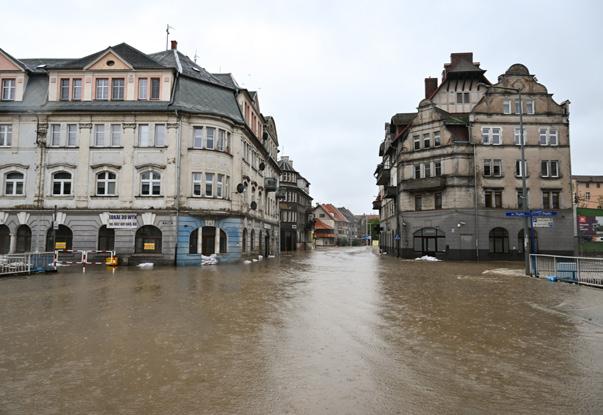
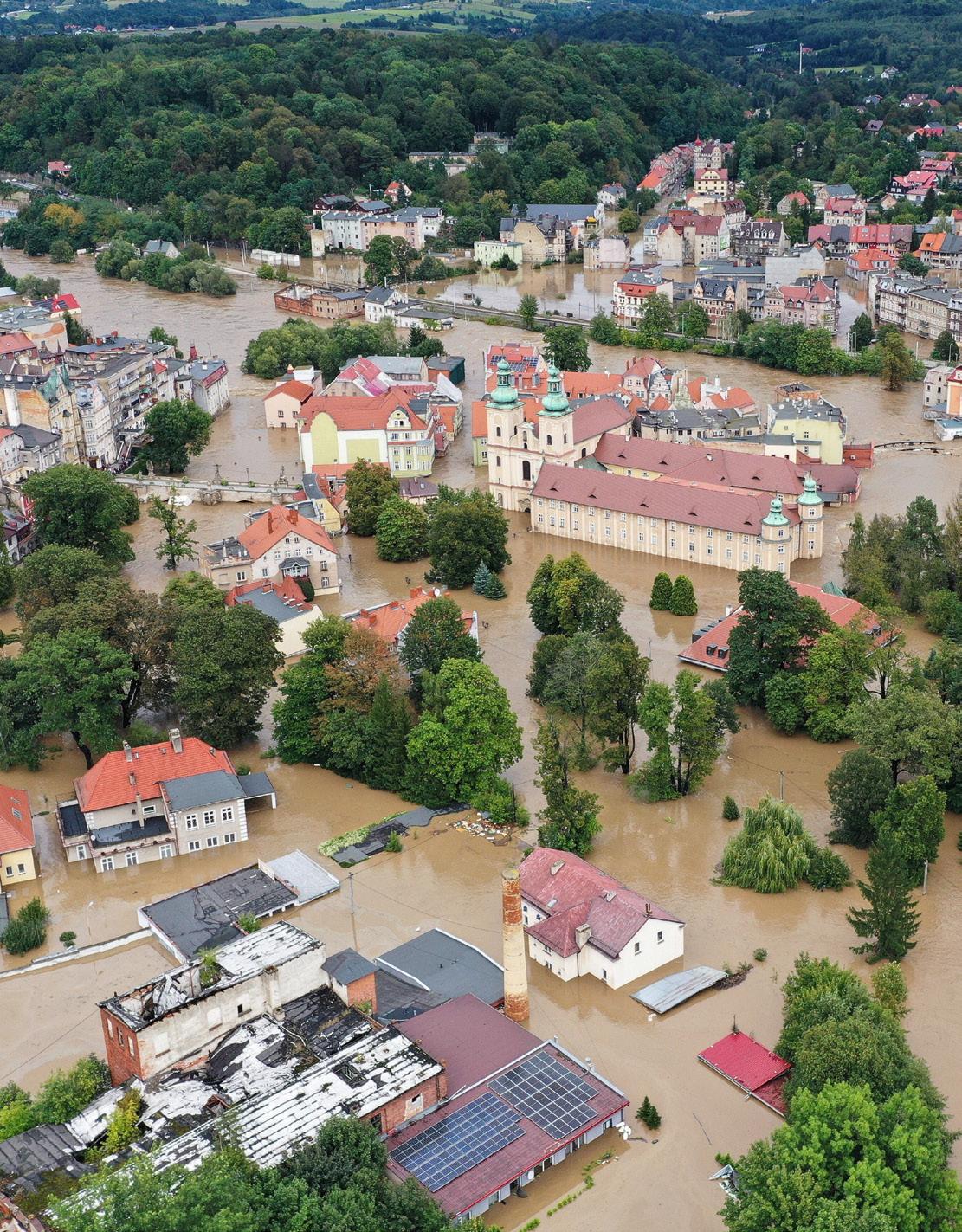
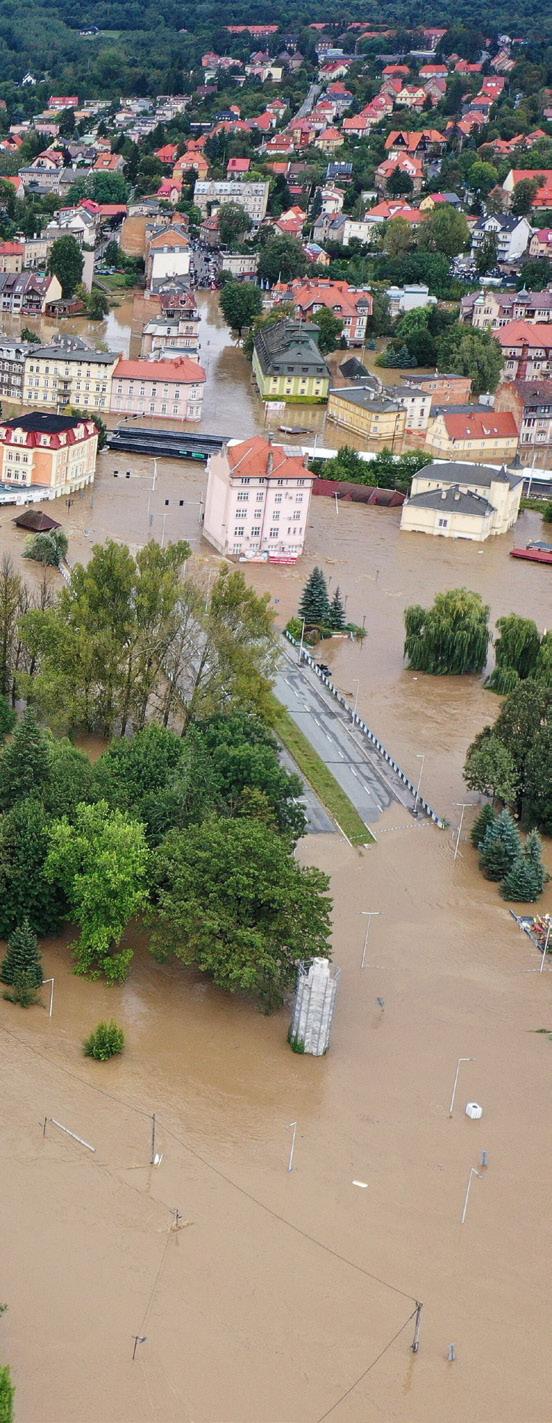
Polish PM Donald Tusk, Slovakian PM Robert Fico, Czech PM Petr Fiala and Austrian Chancellor Karl Nehammer, she discussed the measures taken by the authorities in response to the crisis.
The initiative for this flood mini-summit came from Donald Tusk. It is meant to be a show of EU solidarity, which for the affected countries will be an opportunity to apply for aid from the EU: both current and future, which would finance the reconstruction of damaged areas or flood control infrastructure.
The Polish government plans to spend PLN 2.6 billion on helping flood victims this year, and PLN 1.7 billion in 2025, according to the impact assessment contained in the so-called Special Flood Law, approved by the Council of Ministers.
In subsequent years, the budgeted effort is to decrease: in 2026 and 2027, expenditures are to be about PLN 0.5 billion each, and in 2033 they are to drop to zero. The total by the end of 2032 is to be PLN 9.6 billion, of which the central budget alone is to put up PLN 6.4 billion.
The largest item - PLN 3 billion - is the anticipated issuance of Treasury bonds for the Government Road Development Fund, which usually finances the modernization and expansion of local roads. A total of PLN 1.3 billion is to be allocated for national roads and highways, and PLN 1 billion for the Rail Fund, which will cover losses and damages to the rail network.
At least PLN 500 million has been set aside to support housing investments, about PLN 320 million for social policy tasks, and about PLN 118 million for special compensation for services involved in the ongoing fight against the elements.
There are also other sources of assistance for flood victims. Their housing loans are to be repaid for a year by the Borrower Support Fund, which is made up of banks rather than the state budget. Also not included in the special flood law is the already launched support in the form of emergency benefits (in the amount of PLN 10,000, for which a total of PLN 100 million has already been paid out), or state aid for house and apartment repairs (up to PLN 200,000).
Katarzyna Pełczyńska-Nałęcz, Minister of Funds and Regional Policy, reported that preliminary talks have begun with Brussels on changing the rules for the use of EU


funds. The first funds could be released within a few weeks. According to the assumptions, about EUR 1.5 billion is to be directed to reconstruction in the broadest sense (including the rehabilitation of single-family homes), and EUR 3.5 billion is to be directed to improving flood control infrastructure.
“We assume at the moment that within the framework of the Reconstruction+ plan, together with European funds, we will be able to mobilize up to PLN 23 billion,” Donald Tusk concluded.
The government’s plenipotentiary for reconstruction of the country after flood damage will be the former Minister of Internal Affairs and Administration, now MEP Marcin Kierwinski, Tusk announced.
“We will have to allocate billions of zlotys wisely and quickly, so that they go where they are really needed. It takes cooperation with the administration, with the services, with local government. I was looking for someone who is actu-

THE CATASTROPHIC FLOODING THAT HIT THE SOUTHERN REGIONS OF POLAND IN SEPTEMBER LEFT NINE PEOPLE DEAD AND 4772 EVACUATED FROM THEIR HOMES
ally and technical background, is an experienced politician when it comes to management, has local government experience, has experience with emergency institutions. And frankly speaking, such a person came to me right away,” Tusk said at the crisis staff meeting.
A very thorough audit of what failed during the floods has been announced by the PM in the Sejm. There will also be new flood control investments.
The head of government briefed MPs on the government’s actions during the floods. As he said, although the scale of rainfall in southern Poland and this part of Europe was greater than during the “flood of the century” in 1997, a disaster like the one nearly three decades ago was avoided. “Large cities, large population centers, such as Wrocław and Opole, were saved from this great water,” Tusk stressed, adding that, according to preliminary estimates, flooded and destroyed dwellings are ten times less than in 1997.
“You have the right to say that the relief action came too late. We will be doing a very thorough audit of where what failed,” Tusk assured.
The PM reminded that those affected are entitled to up to PLN 10,000 in non-refundable support, among other things.
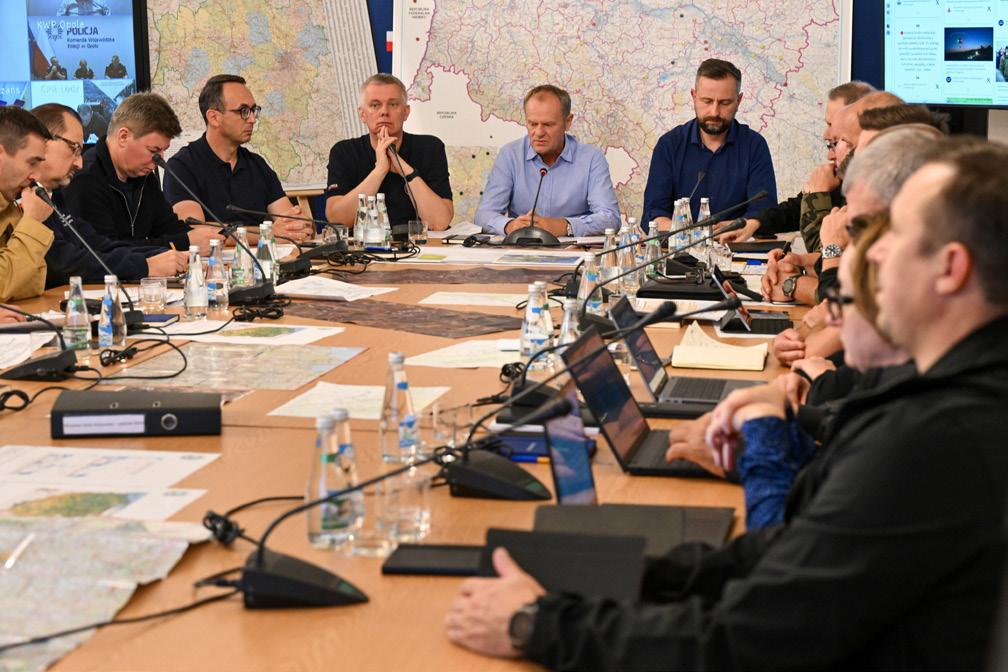
“At the moment well over 30,000 of these benefits have been paid within days,” he said. Going forward, the state is to pay up to PLN 100,000 to rebuild outbuildings and up to PLN 200,000 to rebuild destroyed houses and apartments. “I also want to make it clear that wherever there has been very massive damage, where it will be necessary to rebuild from the foundations or to move residents from obviously flooded areas, where rebuilding will not make sense, the state will also take on this organizational and financial effort,” the head of government declared.
Tusk also referred to the wave of disinformation that emerged during the floods. As he said, the purpose of his decision to open part of the emergency headquarters’ deliberations was to ensure transparency, but also to build public confidence in the actions of the services.
“There have been falsehoods, lies about some local authority somewhere blowing up embankments to flood some locality,” he said, adding that one of the leads in the case leads to Russia. “We have documentation that this was an organized action by Russian trolls. These are more or less the same accounts that were very active during the COVID-19 pandemic,” Tusk informed.
The catastrophic flooding that hit the southern regions of Poland in September left nine people dead and 4772 evacuated from their homes. At the peak of the floods, more than 150,000 customers were without power. Waterworks were also out of service, with water being brought to the most flooded villages. Local road infrastructure was severely damaged, and water also destroyed several bridges. Local authorities are estimating the losses, which they say could reach tens of billions of zlotys.
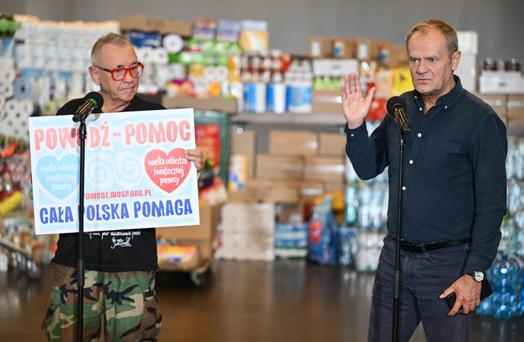
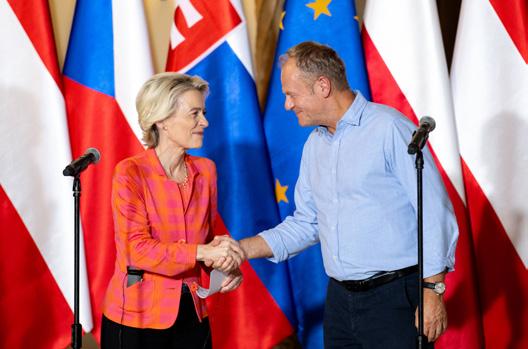
Inflation in Poland in August was 4.3 % year-on-year, the Central Statistical Office ( GUS ) reported.
The reading is the second in a row above the National Bank of Poland’s (NBP) inflation target (2.5% +/- 1 percentage point), after 4.2% in July. Previously, from February to June, inflation was within the NBP’s target - ranging from 2% to 2.8%. August’s result is also the highest this year; previously higher inflation was recorded in December 2023 (6.2%).
The main “culprit” of inflation is July’s partial unfreezing of energy prices. The latest GUS data shows that electricity was 18.5% more expensive in August than a year ago, and gas by 16.6%. However, this is not the only reason why the cost of home maintenance is rising (by 9% year-on-year). The data also shows increases in the price of water and sewerage - about 12% year-on-year.
At the same time, however, economists at ING Bank Śląski point out another factor. “What is worrying is the persistence of service prices above 6% year-on-year and the lack of a downward trend in this area,” they comment. The August data confirmed that inflation in Poland continues to be led precisely by the prices of services, driven, among other things, by high wage dynamics. They grew year-on-

year by 6.2%. The data shows, for example, that beauty and hairdressing services rose year-on-year by 8.6%, social care by more than 11%. In catering and hospitality, prices rose by 7.5% year-on-year, and in education by 9%.
At the same time, commodities rose 3.6%, including food by 4%. This is largely the result of the return to the 5% VAT rate on food in April. At the same time, economists note that in August, the regularly observed holiday decline in food prices (the effect of seasonal minima in fruit and vegetable prices) was small - a mere 0.1% relative to July. This could be an unfavorable prognosis for the rest of the year.
Compared to July, Poland’s consumer price level rose by 0.1% in August. The scale, of course, is very small, but - leaving aside 2021-2022, when inflationary

processes were powerfully unleashed - the last time prices rose in August relative to July was in 2006.
Core inflation, that is, excluding energy and food prices, remains elevated. Economists estimate that it was 3.8% in August, the same as in July. The central bank’s July projection shows that it will remain at a similar level of around 3.5-4% until 2026.
Economists’ predictions for inflation are centered around a level of around 4-5% by the end of the year. At the beginning of next year, price dynamics may still rise slightly, led by base effects and - although this is increasingly unlikely in light of announcements from the government - a further unfreezing of prices for energy carriers.
Around March-April, inflation should pass the peak and move back toward the NBP target. Some experts expect it to go below 3.5% as early as the second half of 2025, others not until 2026. This is also the projection of the central bank.
However, there are quite a few downside risks to these projections (e.g., the “anti-inflationary” effect of a larger-than-expected appreciation of the zloty or the stabilization of energy prices for households), as well as upside risks (e.g., geopolitical factors, the scale of the economic recovery being excessive from the point of view of price stability, or potentially excessive wage growth).
National Bank of Poland Governor Adam Glapinski announced that with inflation stabilizing for about two-three months and projections indicating its unthreatened downward trend toward the NBP’s target, the Monetary Policy Council may proceed with rate cuts. He spoke cautiously about July 2025 in this context.
HICP inflation amounted to 4% year-on-year in Poland in August, Eurostat reported. After more than a year, Poland returned to the EU podium of countries with the highest price dynamics. Only Romania (5.3%) and Belgium (4.3%) had higher inflation than Poland.
The Eurostat figures are different from the CPI inflation reported by the GUS, as the methodologies for calculating them are different. The basket of goods and services for CPI inflation is compiled solely on the basis of the Polish purchasing structure, for HICP - it is the same for all EU countries.
From March to June, HICP inflation in Poland was 2.7-3%, which placed Poland close to the EU average. Now, again, the two statistics have clearly diverged. Average HICP inflation in the European Union in August was 2.4%.
Poland returned to the inflation “podium” in the Union after more than a year. Previously it was on it in July 2023, when HICP inflation reached more than 10%. In 2020-2021 it even happened to lead in this statistic.
September may bring another increase in inflation in Poland of a few tenths of a percentage point. This will be, among other things, the effect of the low base of a year ago. In September 2023, the pre-election reduction of fuel prices at gas stations was underway, the expanded program of free medicines was launched, and the limits on the consumption of electricity under preferential pricing conditions were also raised at that time.
In the following months, CPI inflation is expected to continue on an upward trend and peak in early 2025 at around 5-6%. A lot will depend here on, among other things, the decisions of the government and the Energy Regulatory Authority (URE) on energy prices for households.
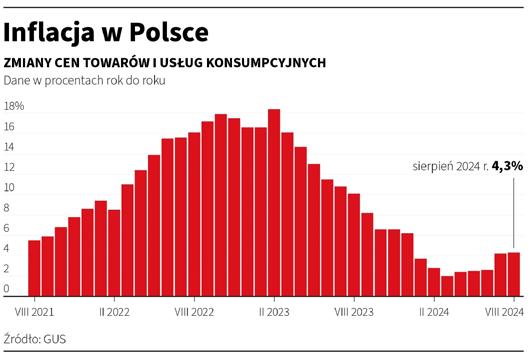
Portugal, the Czech Republic and Poland in Europe, Japan and Singapore in Asia, and Canada in the Americas are the top locations in their respective regions for industrial tenants looking to near-shore supply chains, according to a recent report by the Savills consulting firm.
The Near-shoring 2024 Index compiled by Savills ranks 26 countries based on factors that may be important to companies seeking new locations to shorten or diversify their supply chains, as well as reduce dependence on foreign imports. These factors include economic resilience, economic costs (including rents, energy and labor costs), business environment and ESG performance, among others.
The top five in this year’s ranking include Portugal, the Czech Republic, Poland, Sweden and Japan. The index’s authors note, however, that depending on tenant priorities, other locations with lower rankings may be preferred. These could be, for example, places where costs are higher, but have better environmental and business conditions scores.
“Investors and developers in the logistics real estate sector active in the Polish market have recently benefited from an increased recovery among tenants. The continued popularity of the near-shoring trend is one of the reasons for a 19% increase in total gross demand in the first half of the year compared year-on-year. This allowed Poland to be ranked third on the podium in the Near-shoring Index 2024,” said Malgorzata Lińska-Bator, director at Savills Investment Advisory.
Poland is considered one of the most attractive destinations for companies moving production closer to their customers. The main advantages of the Polish market as a near-shoring location are a shorter supply chain, lower transportation costs and shorter lead times, which are crucial in a dynamically changing economic environment. Locating production closer to markets allows companies to respond more quickly to customers’ needs, as well as to minimize risks associated with disruptions in global supply chains.
“Poland stands out for its competitive cost of doing business, including renting industrial, logistics and warehouse space, and low operating costs. As a mature market, this
makes us among the first-choice countries, especially in the CEE region, while offering access to the single European market,” commented Katarzyna Pyś-Fabiańczyk, Head of Industrial Services Hub, Savills.
The increasing automation and robotization of production is another important factor that attracts companies looking for modern industrial solutions. Automation allows for further cost optimization and increased production efficiency, which is crucial in the context of growing pressure to innovate and adapt quickly to changes in the market.
According to Savills, traditionally low-cost destinations were the biggest beneficiaries of the first wave of offshoring, as companies prioritized costs. After time, with the recent severe turbulence in supply chains and the growing importance of ESG issues, other locations are also being considered in decision-making processes.


„One of the flywheels of nearshoring is the ESG issue. One can see a concentration of investors, willing to place their capital in Poland, on facilities built within the last 5 years or those that are attractively priced and have an appropriate capital expenditure (capex) plan dedicated to ESG matter. Assets of this type will allow to meet ESG criteria, added Lińska-Bator.
Thus, locations that score well in the economic cost category of the Near-shoring Index do not necessarily score highly in terms of resilience, business environment and ESG. The exceptions are Poland, Portugal and the Czech Republic, which offer a unique combination of low costs, economic stability and access to the European single market. South Korea plays a similar role in the APAC region, offering lower costs, although it ranks lower than other APAC countries such as Japan and Singapore.
The initial concern about near-shoring was the potential complete transformation of global supply chains. The reality, however, turned out to be more complex. Companies deciding to relocate production continue to focus primarily on cost reduction, making lower-cost locations remain attractive. However, factors not directly related to cost are also increasingly important, such as access to modern technology, educational facilities and the human factor.
“Poland can distinguish itself from other locations by combining different potentials and offering competitive operating costs while having access to modern technologies. In addition, sectors that are more susceptible to geopolitical influences, such as semiconductor manufacturing or electric vehicles, will increasingly choose countries such as Poland because of its combination of economic stability, strategic location and access to a skilled workforce,” said Pyś-Fabiańczyk.
“Poland, being an important trade hub between Asia and Europe, became even more prominent in nearshoring processes after the outbreak of war in Ukraine. Manufacturing companies considering moving to Poland as a leading country in the Central and Eastern European region are positive about the opportunity to benefit from a skilled labor force, proximity to major markets in Western Europe, and a significant share of relatively young logistics and industrial resources, which have almost doubled in size over the past five years,” Lińska-Bator added.
Savills is one of the leading international real estate advisory firms. It was founded in 1855 in the United Kingdom. It has a network of more than 700 offices in the Americas, Europe, Africa, Asia-Pacific and the Middle East. It offers a wide range of professional consulting, management and transactional services.
According to the Central Statistical Office ( GUS ) , more than 25.2 million people used hotel facilities in 2023 - a record since 2009, when statistics began to be available.
CCushman & Wakefield’s MarketBeat report shows that the volume of investment transactions in Poland rose 82% year-on-year to EUR 83 million. This shows that the hotel market is stabilizing and even strengthening after last year’s fluctuations.
“The hotel industry is very sensitive to various external factors, such as the geopolitical situation, inflation or changes in travelers’ preferences. In resort hotels, even the weather is of great importance. However, after a period of major upheavals related to pandemics, galloping inflation or the war in Ukraine, it is clear that the hotel market is gradually stabilizing,” the expert, regional director of operational sales at the HR Group hotel chain Katarzyna Niezgoda, also admits.
“The business and conference hotel segment, where the HR Group network is most strongly represented, is also clearly seeing a recovery in the MICE area. This does not yet mean a return to 2019 levels, but it allows us to look to the future with optimism,” she added.
This optimism in the industry has been evident since the beginning of the year. In a report by mBank, 57% of hotel owners are satisfied with the results of 2023, although 30% admit it was good, but below their expectations. STR Global, meanwhile, reports that in the first half of 2024,


THE UPTURN IN THE MEETINGS AND CONFERENCES INDUSTRY IS ALSO A POSITIVE TREND. CLIENTS ARE ALREADY BOOKING THEIR FIRST EVENTS FOR 2025, WHICH SHOWS THAT THE SALES WINDOW IS GETTING LONGER AGAIN, AND THIS ALLOWS FOR BETTER SALES PLANNING
Warsaw was the only market among CEE-6 capitals where occupancy rates exceeded pre-pandemic levels - albeit only by 1%. Cushman & Wakefield, in its MarketBeat re-
port, says that in the first half of 2024, the Warsaw hotel market saw a marked increase in demand of around 17% compared to the first half of 2019, and thus returned to pre-pandemic levels.
“Everything indicates that this year - despite various adversities - will be a good year for the hotel industry. The drop in inflation can support domestic tourism. At our Vienna House by Wyndham hotels in Warsaw and Kraków, we are seeing an increase in the number of bookings by foreign tourists - not only European tourists, but also tourists from the United States or Arab countries, as well as the Czech Republic, which is especially evident at our seaside resort - Vienna House by Wyndham Amber Baltic Międzyzdroje,” Niezgoda said. “The upturn in the meetings and conferences industry is also a positive trend. Clients are already booking their first events for 2025, which shows that the sales window is getting longer again, and this allows for better sales planning. The full recovery of the market is still lacking large international events, which have been generating significant revenue for both hotels and other segments in major cities in Poland,” she added.
HR Group is one of the leading multi-brand hotel chains in Europe. Its portfolio currently includes nearly 200 hotels ranging from economy to luxury standards in key European destinations. In Poland, the chain manages 6 hotels under the Vienna House by Wyndham brand in Kraków, Katowice, Łódź, Warsaw and Międzyzdroje.
According to the latest report by international consulting agency Cushman & Wakefield, the second quarter in Poland ' s warehouse sector saw a marked increase in tenant activity. The level of demand in this period recorded the best result in Europe.
In terms of supply, the Polish market will soon exceed the threshold of 35 million sqm of warehouse stock. The first half of 2024 ended with a total demand of nearly 2.7 million sqm, a strong 22% year-on-year increase.
“Tenants more than made up for the weaker result from the first quarter of this year by leasing as much as 1.76 million sq. m. of warehouse space in the following three months.
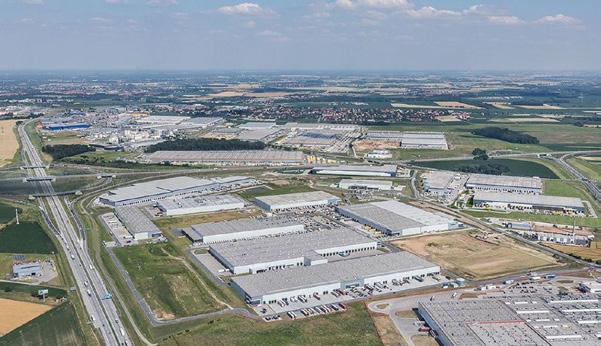
This is the best result in the European warehouse market and the second time that quarterly demand in Poland exceeded the values observed in Germany. It is worth mentioning that as much as 56% of the total leasing volume in the second quarter was accounted for by large transactions ranging from 20,000 to 130,000 sqm,” comments Damian Kolata, Partner, Head of Industrial & Logistics/E-Commerce CEE, Cushman & Wakefield.
The three largest leases at the time were in the Wrocław and Bydgoszcz-Toruń markets. In the Wrocław area, an additional 126,000 sqm was leased by an international e-commerce platform, while LX Pantos extended its contract and expanded its lease to 100,000 sqm. And near Bydgoszcz, LPP Logistics has opened a warehouse to handle online orders on 104,000 sqm.
As last year, about 60% of space was leased under new contracts and expansions, which closed at 1.66 million sq. m. (24% year-on-year increase). Extensions accounted for the remaining 40% of demand.
“Significant changes were noted in the industry structure of net demand, with a marked increase in the share of retail and e-commerce companies accounting for 34% of signed contracts. In contrast, the share of logistics operators declined to 22%, compared to 36% in the first half of 2023. The continued growth of the e-commerce sector, the popularization of ESG

strategies and thus the search for higher quality space, and nearshoring processes should support demand in the long term,” adds Adrian Semaan, Market Analyst, Cushman & Wakefield.
As of June 2024, the total stock of warehouse space in Poland stood at 33.52 million sqm, up 9% year-on-year.
“The warehouse market in Poland continues to grow dynamically. In the first half of 2024, developers delivered 1.64 million sq. m. and slightly less is scheduled for completion in the second half of the year. Thus, the total warehouse stock in Poland will soon exceed 35 million sqm,” Kolata said.
In the second quarter, developers delivered nearly 786,000 sqm of new space to the market, of which 44% remained vacant. This, in turn, led to a renewed increase in the volume of vacant space, which stood at 2.80 million sq. m. at the end of June. The vacancy rate rose slightly to 8.3% (+1.6 pp y/y and +0.1 pp k/k), the highest level since September 2020 (8.5%). Over the past 12 months, the largest increases in the vacancy rate were recorded in the Lubuskie (up 8.6 pp. to 19.3%), Pomorskie (up 5.6 pp. to 7.1%), Małopolskie (up 4.9 pp. to 6.1%) and Łódzkie (up 3.1 pp. to 10.8%) provinces. Noteworthy declines occurred in the West Pomeranian (by -3.4 pp. to 4.0%), Silesian (by -1.9 pp. to 5.9%) and Wielkopolska (by -1.0 pp. to 5.9%) regions.
“Development activity has declined slightly, which, together with a marked drop in the volume of speculative investments, may lead to a compression of the vacancy
IN THE SECOND QUARTER, DEVELOPERS DELIVERED NEARLY 786,000 SQM OF NEW SPACE TO THE MARKET, OF WHICH 44% REMAINED
rate over the next 9-12 months. In the second quarter of 2024, construction began on about 460,000 sqm, of which only 184,000 sqm was speculative. Thus, a total of 1.99 million sqm was under construction at the end of June,” Semaan said.
On a regional basis, the highest construction activity is observed in the Lower Silesia region, where 568,000 sqm is under construction, with as much as 40% of it in the P3 Wrocław project in Kąty Wrocławskie for an international e-commerce platform. The Silesia region (156,000 sqm, including 81,000 sqm speculatively) and the Mazovia region (146,000 sqm, including 67,000 sqm speculatively) saw the largest number of new developments launched in Q2.
In the first half of 2024, monthly base rents remained stable at EUR 3.60-6.50/sqm for BIG-BOX projects and EUR 5.00-7.50/sqm for SBU/City Logistics projects. Thanks to financial incentives offered to tenants, including periodic rent exemptions or subsidies for space adaptation, effective rents can be lower by up to 15-25% from base.
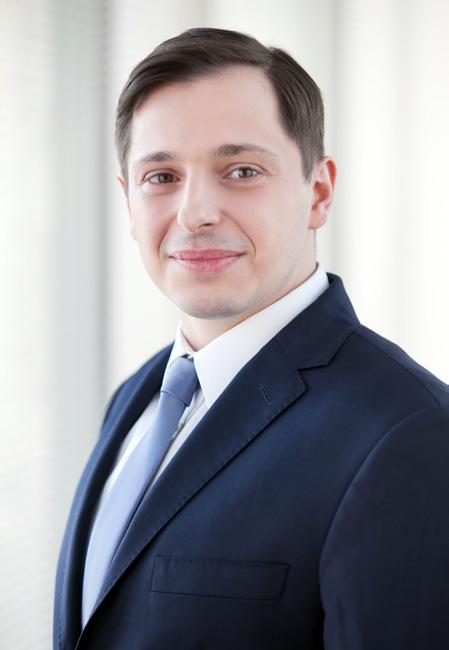
Compiled by Marzena Robinson



1/ Dazzling duo of cosmic creations
Delphinus and Centaurus are two new woody amber fragrances recently launched by The House of Creed as part of The Amber Universe collection which looks at a star-adorned night sky for inspiration.
Named after the cosmic constellation, a radiant fragrance Delphinus depicts its namesake through a choice of notes. It opens with smoky swirls of Incense enveloped in the luminous aura of Black Pepper and Pink Pepper, followed by a heart of sweet Almond, Heliotrope and Orchid casting sparks of light into the darkness with opulent Iris glimmering like precious stardust. Rounded off with Sensual Patchouli, Tonka Bean and delicious Bourbon Vanilla, Delphinus leaves a golden glow reminiscent of distant stars.
Inspired by the grandeur of one of the largest constellations in the cosmos, a bold and fiery Centaurus burns as bright with intense notes of Tobacco, enhanced by a spicy blast of Pink Pepper, Cinnamon and Cardamom. This powerful radiance is tempered by the gentle tones of Sandal-
wood, Jasmine and Heliotrope, reminiscent of stars twinkling in the night sky. The fragrance rests on a warm base of Bourbon Vanilla, Ambroxan, Benzoin and Tolu Balsam which together leave a long-lasting starlike glow.
2/ Celebration of new beginnings
The latest fragrance from Casamorati by Xerjoff - Levar Del Sole is a poetic and uplifting fragrance that captures the magic of a new day on the skin. Literally translated as “rising of the sun”, Levar del Sole has been inspired by the immortal phoenix, symbolizing rebirth and evoking the dawn of new hope.
Levar del Sole Eau de Parfum opens to vibrant accords of Citrus and delicate notes of Roses, chosen and hand-picked especially for Casamorati from India’s perfume capital, Kannauj. Spicy and floral notes of Cardamom, Violet, and Lily at the heart evoke prosperity and renewal. Transformations unfold, as the senses lean into the warm and sensual blend of Musk, Tonka Bean and sweet Caramel at the base.

3/ Olfactory journey to India
French niche perfume brand Memo Paris has added a new fragrance to its Cuirs Nomades collection – Indian Leather. This floral, gourmand, and woody perfume is a tribute to the Indian Oud combined with a leather accord - delicate, but at the same time extravagant.
The rhythm of its composition is therefore determined not only by Oud essence, but also by resinous notes of Olibanum and Styrax, absolutes of Rose and Jasmine, as well as Vanilla Bean extract and Patchouli oil. The characteristic leathery-woody, deep accord unfurls around a Cypriol heart, a plant growing on the banks of Indian rivers, whose intensely green, smoky aroma is used as a ritual fragrance on women’s traditional saris.
4/ Intoxicating shot of destiny
Dear Karma is the fifth fragrance in the Crazy collection by the House of Oud.
The perfumer behind the new creation, Christian Calabro, has chosen to work around an ingredient with a controversial history -

Absinthe. The note of this aromatic, woody and bittersweet spirit, traditionally served with a sugar cube and loved by artists, adds vital energy and mysticism to Dear Karma.
In the top notes of this multifaceted composition ethereal swirls of Incense envelop the lush petals of a Rose, uplifted by the fresh, green notes of Neroli and the intriguing chill of frozen Absinthe.
At its heart, the sweetness of burnt sugar harmoniously combines with vibrant Saffron, rich Patchouli, and Myrrh. The velvety base is a precious blend of Leather and warm oriental Woods.
5/ Holy Grail of skincare Menard, a premium cosmetics brand from Japan, has launched a new addition to its luxurious Authent anti-aging skincare series.
The innovative formula of Authent Liquid contains Rowan Fruit extract, considered a sacred tree in Northern Europe, Pimpinella Anisum (Anise) seed extract, used as a health-promoting herb since ancient Rome, and oil-soluble Sweet Cherry seed extract which boosts skin hydration.



The liquid’s rich yet fresh texture spreads smoothly, absorbs well and helps soften the skin, enriches it in moisture, giving it plumpness and firmness.
Authent Liquid has a feminine fragrance born from blending high-quality natural essential oils of two Roses, Orange Flower, Violet, and Ambrette Seed oil.
6/ Masterful blend of contrasts
A new exquisite addition to the portfolio of Luxury Perfume House of Amouage –Guidance 46 Exceptional Extrait is a new interpretation of the original Guidance Eau de Parfum, one of the brand’s most celebrated scents.
Composed by acclaimed perfumer Quentin Bisch, under the direction of Chief Creative Officer Renaud Salmon, the scent, which was released last year, reinterpreted the Amouage triad of Rose, Frankincense and Ambergris.
The Guidance 46 takes the original’s distinctive blend of Pear, Hazelnut, and Sandalwood, enhancing its contrasts and complexities to offer an intensified sensory experience
that captures the essence of paradoxes with an artistry unique to high perfumery.
Inspired by the latest trends in aesthetic medicine this tightening moisturizer addresses specific issues on the face providing a lifting and plumping effect to minimize the effects of gravity on the skin, such as marionette lines and poorly defined chin, while defining facial contours and improving the loss of volume that occurs over time.
Formulated with an effective combination of advanced anti-aging active ingredients like GravZero Fusion, Rejuvenix GF and Densolift System, this cream bolsters skin density and firmness, visibly improves its texture and tone, provides a lifting effect and helps to reduce saggy skin.
The cream is perfect for those who have not started medical-aesthetic procedures and looking highly effective, less invasive skincare. It is also ideal for use between medical-aesthetic procedures to help maintain results and complement the effects of dermal fillers.
Audiences of Warsaw’s 18th Five Flavours Film Festival of the Southeastern and Eastern Asia cinema will find themselves under the skies of the Japanese capital this November.
An avant-garde manifesto, poetic stories inspired by magical realism, pop-culture classics, independent gems or road movies will invite the viewers to take a stroll through the streets of the world’s largest city as part of the “Tokyo Stories” section.
Different facets and local contexts of Japan’s capital inspire filmmakers, while also shaping collective perceptions of Japan. This great metropolis, home to nearly 40 million people, is simultaneously a vast and cramped space and the setting for many coincidences and encounters, with micro-narratives waiting to be discovered in its many corners.
“Tokyo Stories” offers a portrait of the city spanning six decades. Starting in the 1960s, when Shinjuku became the epicentre of countercultural movements, through the neon-lit 1980s and the uncertain 1990s submerged in the economic crisis, into the whimsical present, where modern visions challenge the stereotypes surrounding Japan’s ‘here and now’. From the buzzing energy of the bustling city centre to the quiet outskirts suspended in
lazy timelessness, “Tokyo Stories” is a kaleidoscope of narratives that together capture colourful diversity of the city filled with paradoxes and unexpected meanings.
Many of the films presented in the section have been unavailable in the festival circuit for years. Some will be screened in a restored version. The programme will feature eight works by Japanese masters, all with strong ties to Tokyo.
Among them is Toshio Matsumoto, whose New Wave manifesto, Funeral Parade of Roses, restored in 4K, remains one of the most striking portrayals of the queer underground in 1960s Tokyo. Equally intense is Tokyo Fist, a frenetic creation by Shin’ya Tsukamoto, which tells the story of Tokyo through the lens of body horror and boxing film conventions. The quiet dramas of Hiroshi Ishikawa and Hirokazu Koreeda will offer a sense of serenity. Steeped in Tokyo poetics, “tokyo. sora” is perhaps the most beautiful film about the phenomena of urban loneliness ever made. The cinephile comedy “Air Doll”, on the other hand, invites us to look at the cityscape through the eyes of a sex doll working in a video store.
Five Flavours Film Festival will kick off on November 13. All “Tokyo Stories” titles will also be available online.


The new exhibition at the Ujazdowski Castle Centre for Contemporary Art (CSW) entitled “Making New Worlds Instead of Forgetting About It” features over 30 works from the CSW’s video art collection.
The selected films, projections, video installations, and video objects, dating from the years 1973–2018, are accompanied by three computer-generated works that employ the aesthetics of early video works.
CSW was the first non-alternative institution in Poland the works of video artists, or more broadly, media art, in a pioneering way, as early as the first half of the 1990s. Some of them were produced at the centre as part of ongoing projects over many years.
For the first time, video art from the Ujazdowski collection is shown in a separate exhibition to demonstrate its potential in a diverse and broad context.
The video artists featured at the exhibition include Wojciech Bąkowski, Oskar Dawicki, Heidrun Holzfeind, Zuzanna Janin, Christian Jankowski, Marcus Kaiser, Andree Korpys, Markus Löffler, Norman Leto, Zbigniew Libera, Tony Oursler, Joanna Rajkowska, Józef Robakowski and Artur Żmijewski.
On view till January 19, 2025
AAfter more than 50 years in the music industry, Bonnie Tyler, the 72-year-old Welsh rock and pop singer with distinctive, smoky voice is coming to Warsaw to give a concert on December 13 as part of her ongoing European tour.
As the motto for the tour she has chosen the 40th anniversary of her breakthrough, multi-platinum single “Total Eclipse of the Heart”. When this seven minute-long rock ballad debuted in 1983, it stormed international charts and sold over nine million copies worldwide.
With a career spanning decades and around 20 million records sold, Bonnie Tyler is recognised as one of the most successful female artists in the world. Her singles and albums have gone gold or platinum in many countries. She has been honoured with an Echo award for her achievements and nominated for a Grammy Award several times.
In 2019, she released an album Between The Earth And The Stars featuring some of her duets with global stars like Chris Norman, Rod Stewart and Cliff Richard. Her 2021 studio album The Best Is Yet To Come was inspired by 80s pop-rock and includes covers of favourite tracks from those years.
During the Warsaw concert, audiences will hear Tyler’s greatest hits such as “Total Eclipse of the Heart” and “Holding Out for a Hero” from the film Footloose and a selection of her new songs.

TThe Polish National Ballet open its new season with the staging of a new production - Edward Clug’s Peer Gynt. Its premiere is set at the Teatr Wielki National Opera in Warsaw on October 25.
The arrival of Peer Gynt to the Polish stage was long due, given the fact that choreographic takes on Henrik Ibsen’s dramatic poem set to Edvard Grieg’s famed incidental music were staged around the world before. It was finally the production by Clug, a Slovak choreographer of Romanian origin, created for his Maribor-based company and then staged on a few European stages, that attracted the attention of Krzysztof Pastor, the director of The Polish National Ballet, who invited the artist to the Warsaw stage.
Peer Gynt tells the story of the downfall and subsequent redemption of a legendary fantasist, a lazy but ego-driven adventurer whose reality is full of emotional extremes and mis-


demeanors. While theatre makers find Ibsen’s play to be rather challenging to mount on the stage, the dramatic poem with episodic structure featuring fantastical elements turns out to be perfect material for a ballet.
Not intimidated by the original’s broken narrative, leaving questions about the meaning of the protagonist’s individual adventures unanswered, the ballet uses a very contemporary visual language, without treating the Ibsen play as a dusty old fairytale inspired by folklore.
Grieg’s music naturally plays a crucial role in the performance. The score combines two suits created from incidental music to Ibsen’s play as well as the composer’s other instrumental pieces: String Quartet in G minor Op. 27, Piano Concerto in A minor Op. 16, and a selection of Lyric Pieces, which in the choreographers view perfectly portray the atmosphere of the poem.
Clug’s true fascination with Ibsen’s ambiguous dramatic poem produced a surreal ballet with elements of the theatre of the absurd, palpably gloomy, yet marked with a large measure of irony. The choreographer managed to capture both aspects of Peer Gynt, which is both a fanciful féerie and a story of a man’s growth into maturity. And so the performance works in an extraordinary way: it portrays a fantastical world which turns out to be very close to present-day reality.
Alexei Baklan will conduct the Orchestra of the Polish National Opera.
Eivør, an acclaimed Faroese singer-songwriter who hypnotizes concert audiences with her distinctive voice will play at Warsaw’s Progresja club on October 19.
Eivør is an artist perfectly attuned to the savage vicissitudes of nature. Born (in 1983) and raised in Syðrugøta, a tiny community with population of 453 on one of the northerly Faroe Islands, she grew up surrounded by a harsh, windswept landscape and the North Atlantic, a rugged backdrop that has, unsurprisingly, deeply influenced the music she creates.
With eleven studio albums under her belt, as well as numerous collaborations with artists including Àsgeir, John Grant, Einar Selvik (Wardruna) and Dan Heath (Lana Del Ray) Eivør can be considered to be one of the most eclectic artists of the Nordics and one of the most mesmerizing live vocalists of her generation.
In 2021 she was awarded with the Nordic Council Music Prize. She is also a two-time winner of the Icelandic Music Prize, has won the Faroese Music Award and multiple Danish Music Folk Awards.
Eivør is part of a new generation of Nordic artists who are rapidly gaining fans around the world while remaining true to their culture and musical folklore. Her music has been streamed over 1 billion times, and her concert tours have sold out in Scandinavia, Europe, and the United States. Her songs, written together with John Lunn, are the soundtrack to all seasons of Netflix’s flagship series “The Last Kingdom,” in which she also guest-starred. She can also be heard on the soundtrack of the popular video game “God of War Ragnarök,” which earned her a performance at the 10th anniversary Game Awards in Los Angeles. She is currently working on a new album, to be released still in 2024.
With her music rooted in the Faroese ballads Eivør also has a wide range of interests in various music genres spanning rock, jazz, folk, pop and, European classical music. Many of her songs are in Faroese, some are in Icelandic, Danish and Swedish and the most recent tend to be in English. Her music covers a wide musical and emotional range, with themes of love, loss, memory, freedom, nature. She has a voice of extraordinary beauty and character, unique in its intimacy, its effortless virtuosity and range of colours.

n late October the Polish capital city will host the Jazz Jamboree 2024, one of the oldest jazz festivals in Europe.
Its first edition was held in the student’s club Stodoła in Warsaw in 1958 under the name Jazz 1958, and from the following year it was officially known as Jazz Jamboree. After three years the venue was changed to the National Philharmonic and then in 1965 to the Congress Hall of the Palace of Culture.
Throughout over sixty years the festival has hosted almost all of the most outstanding jazz musicians from around the world. Among the most famous performers were Miles Davis, Ray Charles, Thelonious Monk, Dizzy Gillespie, Duke Ellington, Benny Goodman, Dave Brubeck, Wynton Marsalis, The Manhattan Transfer, Bobby McFerrin, Chick Corea, Herbie Hancock, Keith Jarrett and Michael Petrucciani.
In 2017, the Jazzarium Foundation took over the festival from its long-time organizer - the Jazz Jamboree Foundation to reactivate it as the “new” Jazz Jamboree.
Under the slogan “The Second Wave of Polish Jazz”, the new organizers decided to entrust the festival to the leaders of contemporary jazz to work with young Polish musicians in specially initiated projects, not in confrontation with foreign giants. Pieces composed through this collaboration are performed and recorded at the festival.
The line-up of this year’s Jam Jamboree features Joanna Duda Trio, Kris Davis – Diatom Ribbons and Christian
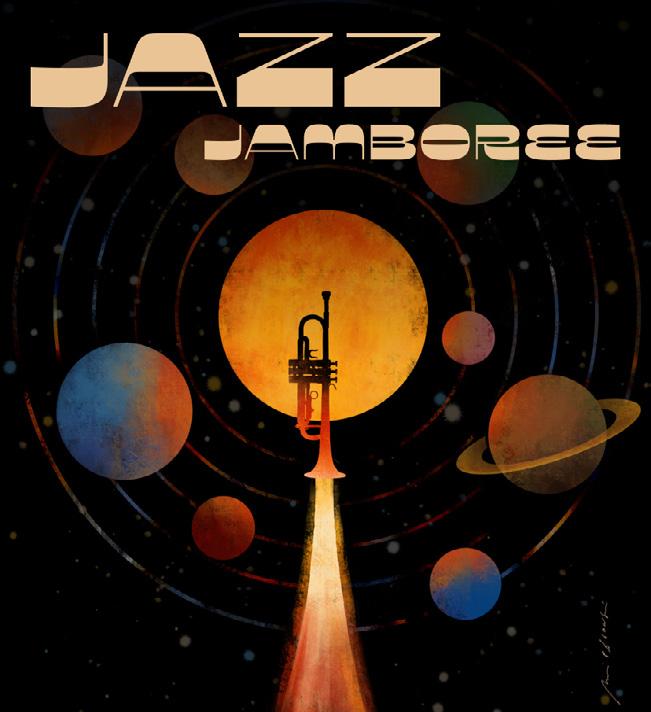
Scott – Chief Adjuah Quintet on October 25. Tomasz Chyła Quintet feat. Kebbi Williams, Phaorah Sanders’Harvest Time Experiment feat. Joshua Abrams, Tisziji Muñoz, Ill Considered Trio and Sun Ra Arkestra on October 26. Raffaele Matta Trio, Eivind Aarset Quartet and Tu-Ner:Trey Gunn – Pat Mastelotto – Markus Reuter on October 27. The festival will be held in keeping with tradition at the Stodoła Club.

The new musical Heathers at the Syrena Theatre telling the story of teenagers and the hardships of growing up is a brutal, predatory and painfully true performance.
“This is not a warm story about youth, it’s a rock slap in the face,” says Jacek Mikołajczyk, Syrena’s artistic director. “We want to offer a musical to young people, which talks about issues important to them, in a language known to them.”
“Here we have a story about rebellion against the rules that govern school communities, about standing up to the whole world, about fatal love, about maturing to understand oneself and fighting for oneself,” Mikolajczak adds.
“The weight of the topics is high with the issues raised here including fighting depression, school bullying, small-town hypocrisy and sexual identity.”
The action takes place in an American high school ruled by three girls named Heather. When the school stars are opposed by the main character Veronica and her boyfriend J.D., the story takes an unexpected and bloody turn and the dead pile up really thick.
“The play deals with the issues of violence and sexual violence, which are very current,” says the director of the musical Agnieszka Płoszajska.
Like many contemporary musicals, this one is also based on the film “Heathers” from 1988 with Winona Ryder (Veronica) and Christian Slater (J.D.) in the main roles.
In 2010, a musical adaptation of the film was created based on the script written by Daniel Waters. Its creators Laurence O’Keefe and Kevin Murphy used the original plot, rock music and explicit lyrics to tell the story of the nightmares of adolescence.
The play turned out to be a huge hit, especially in London’s West End, where it broke popularity records. Since 2018, the play has been revived many times on the stage of The Other Palace in London. The performance has gained cult status among British youth.
The Syrena Theatre is the first in Poland to present a musical adaptation of the “Heathers”, licensed by Concord Theatricals.
The National Musem in Warsaw is showing works of Józef Chełmoński, a highly regarded Polish painter and illustrator and a leading representative of realism who was also active in Munich and Paris.
Chełmoński’s work enjoys a special place in the history of Polish art. For over one hundred years now, his images of nature, genre and hunting scenes and rural landscapes, depicting with a great deal of authenticity the life of peasants and nobles of that time have been considered the essence of “Polishness” captured in paintings from the late nineteenth and early twentieth century.
As a Romanticist, a man with a fiery temperament, a great vital force and a sense of humor, Chełmoński created his art by following his instinct and intuition, independently of any movement. His extraordinary perceptivity and almost photographic memory allowed him to recollect even the most ephemeral of impressions and preserve them on canvas. In his atmospheric and realistic paintings, he wonderfully reproduced the colours of nature.
The exhibition’s narrative reflects key areas of Chełmoński’s interests, showing him as a chronicler of daily countryside life, a great admirer of horses – their beauty, personality and the graceful power of their movements –and a sensitive observer of nature who also noticed its spiritual, religious and mystical dimension.
Chełmoński’was born 1849 in the village of Boczki near Łowicz, central Poland, under the Russian military control. His first drawing teacher was his father. After finishing high school in Warsaw, he studied in the Warsaw
Drawing Class and took private lessons from Wojciech Gerson. From 1871 to 1874 he lived and studied in Munich where he worked with Polish painters assembled around Jozef Brandt and Maksymilian Gierymski. In 1875 Chełmoński went to Paris, where he had many important exhibitions, was noticed and appreciated. His paintings reached prices even 120 times higher than Renoir’s works. In 1887 he returned to Poland and in 1889 settled in the village of Kuklówka near Grodzisk Mazowiecki where he lived until his death in 1914.
Chełmoński’s oeuvre fully reflects the artistic position of the 19th-century realist, based on a perfect painting and drawing technique and a close observation of nature. As opposed to the conventions of realism dominant in Munich and the formula propagated in Paris, Chełmoński’s work was focused on the countryside, presenting the specificity of a country he was emotionally attached to.
The exhibition culminates a research project conducted jointly by the National Museums in Warsaw, Poznań and Kraków.
Till 26 January 2025

The new musical “Bajo Bongo”on the Nova Scena of the Roma Musical Theatre pays tribute to Natasza Zylska, née Natalia Zygelman, a great star of the Polish music scene in the 1950s, whose name is not well remembered after more than six decades since she disappeared from the stage.
Zylska’s musical talent was revealed already in her childhood when he attended a primary music school in Vilnius. After World War II, she appeared on the Polish music scene, winning the hearts of the audience with her warm voice and charisma. Her career peaked in the 1950s, when she performed with the leading dance orchestras in Poland. Her songs were hummed by the whole of Poland, and her greatest hit “Pik, pik, pik” was written for her by Władysław Szpilman himself.
Despite the great successes, she decided to emigrate to Israel, where she devoted herself to the art of ceramics and sculpture. She died in Tel Aviv in 1995.
“Bajo Bongo” directed by Anna Wieczur tells anew the story of the iconic singer’s life and career filled with passion, love and music. The role of Zylska is beautifully played by Anna Sroka-Hryń. Other characters in the play bring the audience closer to the figure of the forgotten artist in a witty and sometimes reflective way.
The story is illustrated with the most famous hits from Zylska’s repertoire in new arrangements by Jakub Lubowicz.

Many big cities have inhabitants whose existence human residents often do not even suspect.
Many species of wild animals have learned to live next to people, in green areas, city parks and gardens, on roofs, attics and in basements. Their fascinating world is being presented by the new temporary exhibition “City of Animals” at the Museum of Hunting and Horsemanship, a branch of the Royal Łazienki Museum.
The exhibition uses Warsaw as an example to show the world of animals that inhabit large Polish cities alongside humans. Selected species of birds and mammals living in enclaves absorbed by expanding cities are presented, as well as those for which specific urban development has created new opportunities. Visitors will also learn to what extent the belief about the domination of humans in large cities is justified.
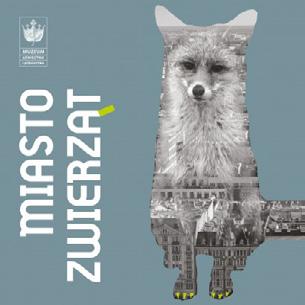
On display are about 50 taxidermies divided into three thematic zones: forests and city parks, the Vistula River and the city centre. The whole collection is complemented by large-format photographs and educational boards on animals in the city and the role they play among people. The exhibits come from the museum’s collection and from the Warsaw University of Life Sciences, the Institute of Forest Sciences and the Independent Department of Forest Zoology and Hunting.
A visit to the exhibition is not only a chance to get to know the animals that share urban space with us, but also an opportunity to think about the future of cities. The project aims to make viewers aware of the importance of even the smallest patches of greenery for preserving biodiversity. As cities develop, protecting these areas becomes essential to improving the quality of life of all residents - both humans and animals.
Until March 2, 2025

Students of the National Academy of Dramatic Art in Warsaw are staging their diploma play The Father (Ojciec), directed by Agata Duda Gracz, in which the title character uses superhuman powers to create, in a drastic way, a perfect work of art – a crucifix hanging in St Mary’s Church in Gdańsk.
The script written by Duda Gracz has been inspired by Oskar Jan Tauschinski’s short story “Sacrilege”. She has reached for a difficult and semantically dense work by an Austrian writer to address the problem of the human creator. A creator who identifies himself with God, and associates his artistic process with the divine act.
As a total artist, in his artistic madness, he believes that
a perfect work can only be created as a result of contact with truth – in line with the idea that true art always comes from cruelty inflicted on people.
This approach affects the construction of the performance, in which the created illusion has close contact with reality. In this way, the viewers ask themselves questions: where is the moral boundary of the artist? Who gives them the right to be an executioner? Can they perform devilish acts while creating in the name of humanity? Does art entitle them to place themselves above the law?
The cast includes Stanisław Kawecki, Klementyna Lamort de Gail, Mikołaj Łukasiewicz, Norbert Panert, Agnieszka Rajda and Jan Sałasiński.

Anew exhibition at Zacheta –National Gallery of Art “Prinz Gholam” presents diverse body of work of an artistic duo involved in performance projects which demonstrate their unconventional approach to traditional artistic media.
Prinz Gholam is the collaborative name of two artists, Wolfgang Prinz and Michel Gholam, who have been working together since 2001 and developing a multidisciplinary approach to their art, which encompasses performance, video, photography and drawing. Their work embodies and reinterprets a wealth of cultural references, spanning ancient and classical art, contemporary creations, literature, media, historic sites, museums, architecture, and the natural world. It is centred around a study of the human body in relation to surrounding cultural constructs and the world in which we live. It consists of choreographic or visual arrangements in which Prinz Gholam use and reinterpret a range of images and postures taken from historical paintings and sculptures, and from films and media sources.
Hailing from different cultural backgrounds — German (Prinz) and Lebanese (Gholam) — their art transcends national contexts. They draw inspiration from diverse cultures and eras, incorporating these elements freely into their work. Their creative practice encompasses performance pieces and choreographies staged in the presence of viewers or for the photographic or film camera, as well as large-scale drawings, stone sculptural objects, and distinctive masks, the latter influenced by the 2020 COVID-19 pandemic.

Prinz Gholam’s unique performative journey started in 2001 within the confines of a private apartment. It began with practising and synchronising static choreographies, blending planned elements with intuitive and spontaneous movements. Photography became integral to their multidisciplinary approach, initially capturing sequences of compositions with bodies arranged to test their limits, in stillness.
The exhibition showcases early photographic works from 2002–2006, documenting their creative process.
Till November 3

There are at least two hypotheses or, rather, legends, explaining how jazz snuck into Tomaszów Mazowiecki and how the jazz bug infected a considerable portion of this smallish town’s residents. And not just them, actually. One version assumes that it happened secretly, gradually and, at least in the beginning, almost imperceptibly. It puts the responsibility on several specific people. The other one describes a triumphant, festive incursion connected with a certain increasingly popular festival.
This year the Love Polish Jazz Festival was held for the eighth time already. Or maybe only for the eighth time? Not important. What is important, though, is that over the years the audience has grown from maybe about a hundred people at the first festival, in 2016, to some eight hundred in September 2024, when patients with syncopation syndrome flocked to Tomaszów from all over the country. As for attendance by Polish jazz stars, it was no better and no worse than at previous festivals. As usual, they were there and they played like mad!
And, also as usual, the musicians who travelled to this peaceful and usually slow-living town included bands whose stars have been shining with a magical light for some decades as well as those that lit up quite recently but have already won recognition on the global jazz firmament.
Urszula Dudziak, a vocalist one might call an instrumentalist of the vocal cords, started her conquest of the world in New York in the 1970s. However, listening to her festival concert in Tomaszów, you’d never guess it’s already been so many decades. And, the fact that the owner of one of few such recognizable jazz vocal sounds has in fact conquered the world was irrefutably confirmed during the concert.
Everyone has heard and remembers her voice even if they haven’t caught the jazz bug yet. In 1979 she first amazed the world with the energizing hit tune “Papaya.” That conquest turned out to be lasting. The piece, filled with optimistic energy, can be heard in every corner of the world to this day.
A VOCALIST ONE MIGHT CALL AN INSTRUMENTALIST OF THE VOCAL
STARTED HER CONQUEST OF THE WORLD IN NEW YORK IN THE 1970s
Everything that Dudziak proposed to musical New York’s audiences back in the mid-1970s and on her first album, produced with another famous Polish jazz musician, Adam Makowicz, was as groundbreaking as it was beautiful and inspiring. And that’s not a mixture of qualities you get too often in new trends in the arts these days. Not even in jazz. Vocals with no text, used purely instrumentally, processed electronically, including live on stage, have been and are the unique features of this lady of jazz. The concert in Tomaszów not only roused the audience, who rewarded the vocalist with a standing ovation. It also proved that despite all the years that have passed since the release of the Newborn Light album, in Switzerland in 1972 and in the United States in 1974, Dudziak consistently sounds phenomenal and simply infects the audience with her energy.
And speaking of infecting, let’s go back to the question: How did jazz end up in Tomaszów? Where does the amaz-



COMPOSITIONS BY KOMEDA WERE ALSO PLAYED IN TOMASZÓW (YES, FOR THE FIRST TIME IN NEW

ing festival audience, still mostly comprising local residents of a town of fewer than 60,000 people, come from? My brief investigation during this year’s visit to the town and the LPJF showed that a large part of the blame goes not to the festival itself but to its initiators. Who do I mean? Three men: a priest, a drummer, and a jazz expert. All of them have close ties to the town. The – regrettably – late Rev. Edward Wieczorek experimented with jazz concerts at his church in Tomaszów at one point. I don’t know if you realize how unusual such an approach to a site of religious worship is in Catholic Poland. The second person allegedly to blame for the jazz epidemic in Tomaszów is jazz drummer Wojciech Lubczyński, whose adventure with percussion began when he was 13 and involved two sticks and a shoebox, sometime in the late 1950s or early 1960s. Where? In Tomaszów, of course, which is his native town and, obviously next to jazz, his great love. The third guilty party, and probably key to the whole matter, is Krzysztof Balkiewicz, a great expert on jazz and researcher of Krzysztof Komeda’s legacy. (Komeda is a legend of Polish jazz, one of the world’s greatest jazz composers. Do you know the lullaby from Rosemary’s Baby? Yeah, that was him.) And where is Balkiewicz from? You’ve guessed itl: from Tomaszów.
According to one believable-sounding story, the key meeting of those three men took place at the Arkady Gallery (Galeria Arkady), one of the most magical places in Tomaszów Mazowiecki. However, the meeting was preceded by a jazz concert at St. Anthony’s Church, organized by Rev. Wieczorek. Musicians from Sweden and Poland performed. A Tomaszów man played the drums. Yup, it was Lubczyński.
“After that concert I came up with the idea to hold a jazz festival in Tomaszów,” Balkiewicz openly takes the blame. “So the three of us met up, discussed the idea, and then went to the mayor of Tomaszów, Marcin Witko.”
THIS YEAR EABS (ELECTRO-ACOUSTIC BEAT SESSIONS), A QUINTET FROM WROCŁAW PLAYING TRULY FUTURISTIC JAZZ, PERFORMED A FEW RECENTLY DISCOVERED EARLY COMPOSITIONS BY KOMEDA
Today the Municipal Culture Center (MCK) is the festival’s organizer. A group of MCK employees handles the side of things we’d probably call logistics. Balkiewicz is the artistic director of the festival.
“I think up the projects. I do my best to make sure they are premieres or world premieres,” he briefly outlines his role. This original character of many LPJF projects has actually been a unique feature of all the editions so far. This year EABS (Electro-Acoustic Beat Sessions), a quintet from Wrocław playing truly futuristic jazz, performed a few recently discovered early compositions by Komeda. (Who found them? Again, you’ve guessed it: Balkiewicz, the indefatigable researcher of all things by or about Komeda.) Of course, the EABS musicians played these never-before-publicly-presented

pieces in their own style, not in the climate of what had been avant-garde jazz in the 1950s. That was when Komeda wrote them and then hid them away in some deep drawer. What was the result of the premiere of the EABS experiment?
A standing ovation. Also, loudly voiced wishes, from the festival stage and unofficially, that the music should make it to the next record released by EABS.
Compositions by Komeda were also played in Tomaszów (yes, for the first time in new arrangements) by the quartet of master accordionist Jarosław Bester. This was a true feast not only for fans of the Bester Quartet’s inimitable sound. The dynamic but also warm, mature sound conjured up associations with the Balkans as well
as a klezmer vibe, not without reason. The Bester Quartet is another incarnation of The Cracow Klezmer Band. Among other things, the enormous attractiveness of the arrangements they play lies in a fusion of experiences, the effect of many years of experimenting with klezmer sounds and works on one hand and what we very generally call jazz on the other. And that original, riveting sound of the Bester Quartet filled in the compositions written by Komeda, an icon of Polish jazz. Also in this case, the result was applause that the LPJF audience stood up to offer the musicians. And there were more wishes, expressed unofficially, that a new record with those arrangements should be produced.


Rediscovering Komeda’s music has been a watermark of consecutive LPJF editions. No wonder, then, that this year Komeda’s songs were also interpreted at the festival (only instrumentally!) by the Piotr Schmidt Sextet with guest musician Mino Cinelu, a world jazz star. He is just as comfortable with drumsticks as with a guitar, flute or bandoneon (a type of concertina, often confused with the accordion). This is a musician who has performed with Miles Davis as well as Weather Report, Herbie Hancock, Cassandra Wilson, and Al Di Meola. There’s no end to the list of stars he has collaborated with! And, I probably don’t have to say this, but… yes, this time there was another standing ovation in Tomaszów.
But let’s go back to the investigation into the jazz epidemic in the town. I came upon an interesting clue when I got to have a conversation at the Arkady Gallery. My interlocutor was someone in the know, namely Mariusz Sobański, the gallery’s owner. Mariusz isn’t just a businessman, he’s more of a good spirit of Tomaszów, only very much alive, given that spirits usually aren’t. His Arkady Gallery is an actual gallery, it presents art. At the same time, though, it’s a popular coffee shop, a place for meetings and conversations. Add to this a small basement that has served as a jazz club for many years, and you get the picture about Mariusz. He’s definitely another person to blame for the jazz bug epidemic in Tomaszów!
The interior of the Arkady Gallery with its charming atmosphere is the result of a very successful conversion of a building that dates back to the first half of the 19th century. It originally housed the town butcheries and other grocery stores. The walls filled with presented paintings show through as an unplastered brick structure. Wherever possi-
JAZZ ACTUALLY CAME TO STAY FOR GOOD IN TOMASZÓW WITH THE RETURN OF KAREWICZ, AND GOT SYSTEMATICALLY INFECTIOUS AT SMALLER AND LARGER SESSIONS IN THE JAZZ BASEMENT OF MARIUSZ’S CLUB, AT CHURCH CONCERTS, AND AT JAZZ PARADES HELD IN TOMASZÓW ALL THE TIME
ble, there are tables and chairs from a period that was especially kind to emerging Polish jazz, i.e. the turn of the 1950s and 1960s. A drum set from the same period stands on an improvised stage at the back.
There is no question: Many clues in my investigation lead to this place. I became even more convinced of this when Mariusz reminded me about a legendary Polish jazz and rock photographer. Marek Karewicz spent his postwar childhood in… yes, you’ve guessed again: in Tomaszów. And later, just a little later, in the 1960s, he became one of the most famous – not only in Poland – music photographers. He designed

THE INTERIOR OF THE ARKADY GALLERY WITH ITS CHARMING ATMOSPHERE IS THE RESULT OF A VERY SUCCESSFUL CONVERSION OF A BUILDING THAT DATES BACK TO THE FIRST HALF OF THE 19TH CENTURY
countless sleeves for records, including jazz ones, released in Poland. Among other things, he was also the official photographer of Miles Davis’ last concert tour and Ray Charles’ European tour. In 1967 he was the exclusive photographer for
the concert of The Rolling Stones, a watershed for the Polish rock scene. That he was also a photographer for all the greatest jazz festivals and concerts in Poland goes without saying.
Apparently like everyone infected with the town’s special atmosphere, he returned to Tomaszów after many years, first with his famous photography exhibition This Is Jazz, in spring 1998. Six months later he came to meet up with his childhood friends. Among them were singer and composer Bogusław Mec, movie director Arkadiusz Drabiński, and jazz trombonist Marek Michalak.
“They’ve come here in great numbers, from around the world and from Poland, all of them originally from Tomaszów. They played improvised jam sessions at the 6×9 Club,” Mariusz recalls, referring to that small jazz basement at the Arkady Gallery.
After talking to Mariusz, I realized that the roots of the flourishing jazz scene in Tomaszów went much deeper than I thought. The Love Polish Jazz Festival is one of the flowers – the most luxuriant, but not the only one. Jazz actually
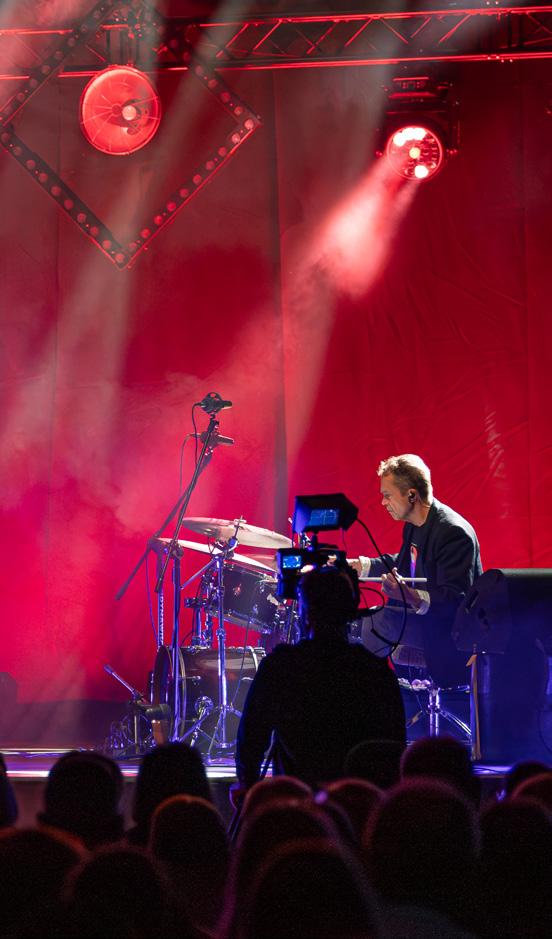
came to stay for good in Tomaszów with the return of Karewicz, and got systematically infectious at smaller and larger sessions in the jazz basement of Mariusz’s club, at church concerts, and at jazz parades held in Tomaszów all the time. Today the bug is being spread ferociously by the LPJF, but also by the Volbórka Jazz Festival that Mariusz has been organizing in Tomaszów for a few years now. Another attraction are the jazz workshops held every year just before the LPJF concerts, drawing in people from all over Poland, not limited to young musicians wanting to get a closer look at how jazz professionals work.
As you can see, many are to blame for spreading jazz in Tomaszów. Over time, the number of intentional carriers of the jazz bug, who absorb and pass it around left and right, has been growing as well. They include Dariusz Kwapisiewicz, a local photographer who has been so successfully infected with jazz and the LPJF that no edition of the festival could do without him. Obviously, he takes pictures of the musicians – after all, he’s a professional photographer. How-
THE EFFECTS OF THE WONDERFUL EPIDEMIC THAT THEY HAVE INDUCED SET THIS TOWN APART FROM ALL OTHERS, EVEN THOSE THAT HAVE THEIR OWN JAZZ FESTIVALS

ever, Dariusz is so good at it that he has already won a number of awards at prestigious international photography competitions. His picture of Richard Bona at the 2022 LPJF won second prize in the Jazz World Photo competition in Prague in 2023 and made it to the finals of the JJA Jazz Award Photo of the Year in the United States. The list of prestigious nominations and prizes to his credit is much longer.
“I’m not sure what gives me more joy during the festival: photographing the musicians or listening to them,” says Dariusz, who also supports the LPJF with promotion and graphics.
I’m pretty sure that my investigation in search of those guilty of spreading the jazz bug in Tomaszów Mazowiecki only brushed the tip of the iceberg. The effects of the wonderful epidemic that they have induced set this town apart from all others, even those that have their own jazz festivals. And that group is sizable. Because, you might not have realized it yet, but Poland is the land of jazz.
Compiled by Bartosz Grzybiński


1/ ZTE router
SmNeed high-speed Internet, but fiber optic infrastructure is not available in the area? If so, you can use the ZTE MF258 Pro kit, which consists of an outdoor unit (ODU) and an indoor unit (IDU). It supports LTE Cat 15, which means download speeds of up to 800 Mbps and upload speeds of up to 150 Mbps. The external module provides the best possible quality of Internet performance, without interference
caused by obstacles such as walls. Installation of both devices is very intuitive and possible without calling a specialist. The indoor router supports the latest Wi-6 standard, allowing data transfer at speeds of up to 3000 Mbps. The easy-to-use user panel gives you the opportunity to customize the device to your individual needs. Thanks to it, household members can enjoy a fast and stable Internet connection throughout the building. The router is designed for both
residential and business users. It provides a comprehensive solution even for the most demanding Internet users. www.zteshop.pl
2/ nubia Focus Pro5G
Anywhere and anytime anyone can feel like a real professional photographer with the help of nubia Focus Pro5G. This is all thanks to the Neovision AI system, which is a professional integration of software,


advanced optics and specialized artificial intelligence algorithms developed by the company. The 108 Mpix main camera captures great moments in fine detail so that memories are preserved in the best image quality. At the heart of the nubia Focus
Pro 5G is a powerful 2.2 GHz octa-core processor with 5G support that ensures fast and smooth performance in all conditions at all times. Together with up to 20 GB of dynamic RAM (8 + 12 GB), they

provide an uncompromisingly smooth experience using demanding applications and advanced games. The stylish design is available in glass, black finish and light brown vegan leather. Its design is inspired by classic cameras. www.zteshop.pl
3/ MiVue C595W
MiVue C595W is a car camera equipped with all the necessary features for
high-quality recordings, such as the well-known STARVIS sensor with a bright lens, GPS, Wi-Fi, HDR. One of the more useful features of this model is speed camera warning. The camera will warn not only against them, but also against sectional speed measurement. This innovative feature offered by Mio will protect you from receiving a speeding ticket.
www.mio.com/pl_pl/
Story and photos by Bartosz Grzybiński
Usually automotive brands try to make the model of the car they produce attractive all the time, and therefore every few years they replace it with a completely new generation. Usually, because this is not the case with the Volvo XC 90.
Another facelifted version of the Volvo XC90 has just debuted on the automotive market. Looking at the facelifted version, it’s hard to find any revolutionary changes compared to the 2014 version. The same angular silhouette, the same large grill (well, maybe with a different pattern), the same led headlights with the already characteristic for the brand “Thor’s hammer”, i.e. lights arranged in the shape of the letter T, and the same tail lamps, which themselves have already become a permanent feature of the stylistic Volvo models. The interior hasn’t changed much either, not including the enlarged touchscreen display of the center console. The engine range includes only two gasoline engines and hybrid drives, including a soft hybrid “mild hybrid” and a plug-in rechargeable version. Before the polifting models appear on the roads and streets in greater numbers, let’s take a closer look at the B5 AWD version, offered as a soft hybrid with a turbocharged gasoline engine and an electric motor supporting it and driving both axles.
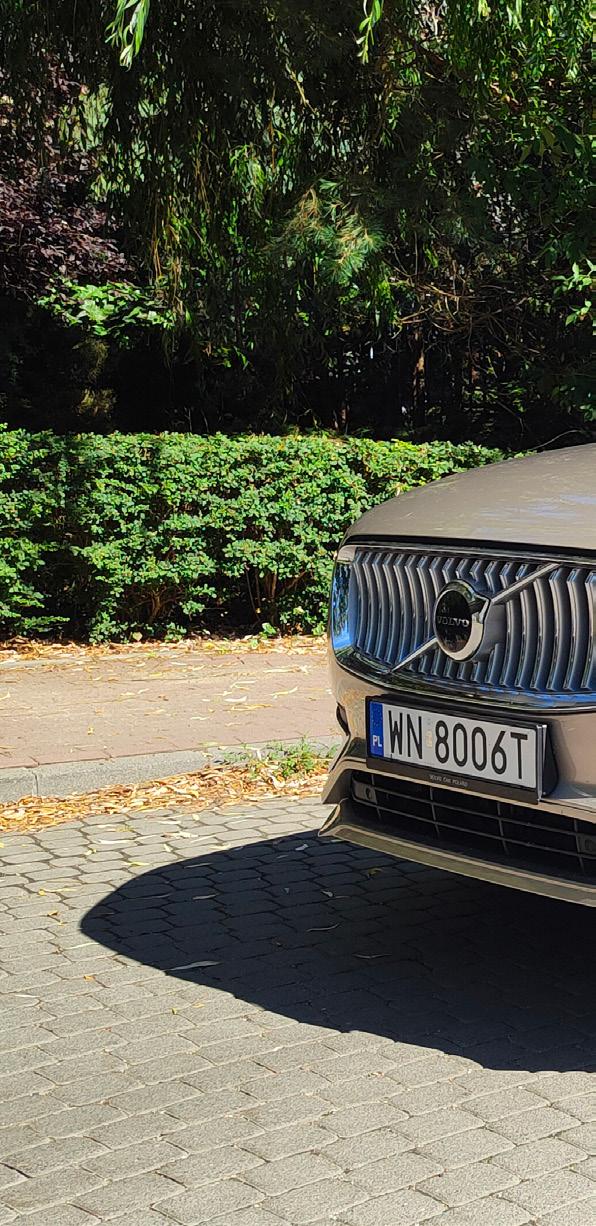
The silhouette of the second-generation 2014 model, which underwent a mild facelift in 2019, still looks modern and sleek, and is often seen as the brand’s calling card. The massive body, measuring 4.95 meters in length, is distinguished by smooth surfaces and a few embossments, including on the doors and hood. The combination of gold exterior paint (Bright Dusk) and 21-inch polished rims is impressive and emphasizes the elegant silhouette. With a wheelbase of 2.98 meters, the interior is very spacious and accommodates five, or optionally - thanks to two folding seats in the trunk - seven passengers. The
trunk holds from 680 to 1,874 liters. Even the seven-seat version still has 314 liters available. In the passenger cabin, traditionally for Volvo, we have Swedish minimalism and an atmosphere of luxury thanks to top-quality trim materials such as Nappa leather, velour, alcantara, wood or alunini inlays, and equipment that includes air suspension, a 360-degree camera system, a suite of safety systems, great Bowers&Wilkins audio, four-zone climate control, heated and ventilated seats, laminated glass, a commuter wheel, parking heater, head-up display and induction charger.

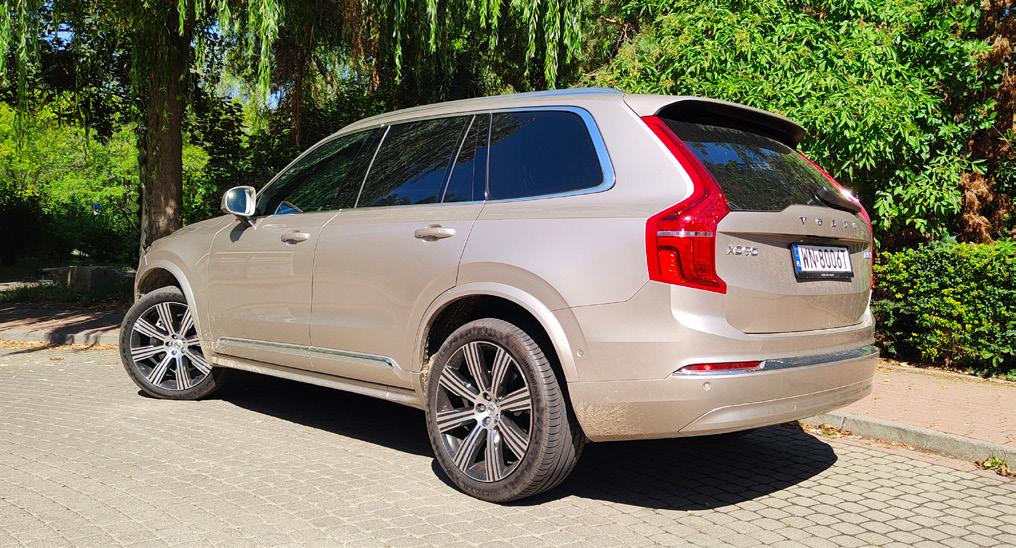
The cockpit hasn’t really changed in over a decade. It still looks good, is ergonomically laid out and easy to read. The command center is the 9-inch vertical screen of the Google Android-based infotainment system, which has

been in the XC90 since the 2019 facelift and is pleasant to use, with very good touch response and Google services, but only wired Apple CarPlay. The easy-to-read digital clocks with a 12.3-inch display and multifunction steering wheel are familiar from other models in the brand like the V90 and XC60.
Under the hood is a 2-liter, four-row gasoline unit with a mild hybrid system with a total output of 250 hp. Maximum torque is 480 Nm/1750 rpm. According to the manufacturer, the car accelerates from 0 to 100 km/h in 7.6 s and accelerates to 180 km/h. (The speed is electronically limited). Drive goes to both axles via an 8-speed Geartronic transmission. The engine is mated to a 14-horsepower electric motor, and it must be said that this hybrid system handles quite well for a car weighing more than two tons. Combustion is quite reasonable for such a large SUV and averaged about 9.5 l/100km during test drives. However, it should be noted that this Volvo model, due to its dimensions, weight of about two tons, large rims and low-profile tires, did not encourage fast driving, it leaned in corners,

VOLVO PROVES THAT WHAT IS GOOD AND PROVEN WILL DEFEND ITSELF AND DOES NOT NEED TO BE CHANGED OFTEN
and its not very direct steering and brakes also left a certain dissatisfaction. Instead, due to its handling qualities, it will be perfect as a luxury family car. Unfortunately, not everyone will be able to afford it because the starting price of this model with this equipment starts at about PLN 330,000, while the model presented with optional equipment costs more than PLN 470,000.
Today it is hard to believe that the XC90 model appeared on the market in 2002. The premiere of this large SUV from the executive segment took place in the United States at the Detroit Motor Show. The first generation was available until 2014, when it was replaced by the next generation, offered practically until today. Although the Volvo XC90 has undergone several facelifts during this time, there have really only been two generations in the past twenty-plus years! When manufacturers are outdoing themselves in presenting constantly new generations of their models, Volvo proves that what is good and proven will defend itself and does not need to be changed often. Has it succeeded in creating a timeless model? I guess so, because after last year’s launch of its electric successor, the Volvo EX90, the XC 90 model is still offered by the brand, and is still one of the most preferred by drivers.


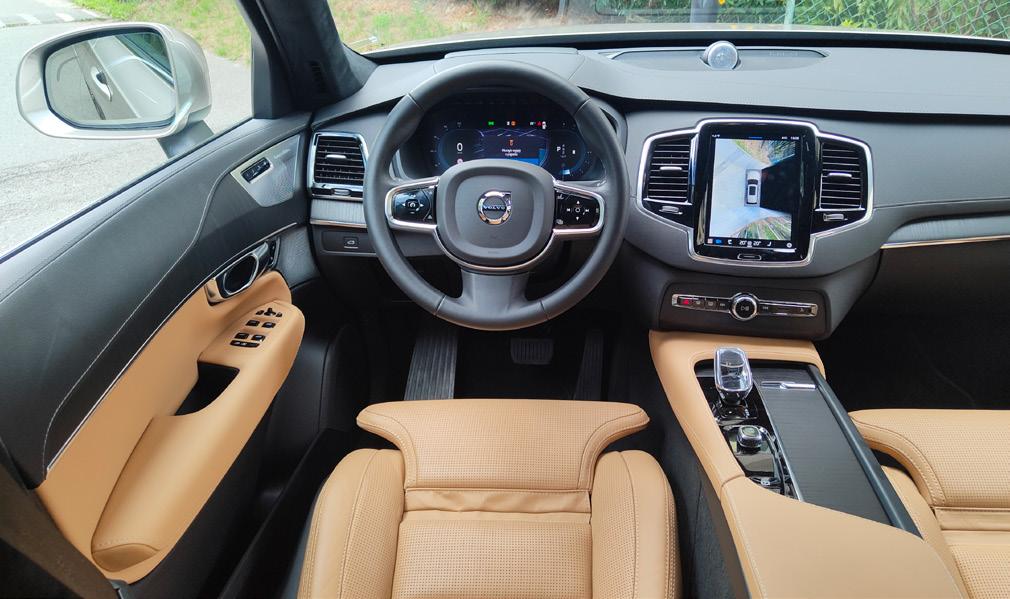
Every third Polish company is considering investing in Ukraine in 2025, even if the war continues. However, entrepreneurs are still waiting to take advantage of billions of euros in EU guarantees.
Among Polish companies, one in ten is “definitely” considering investing in Ukraine, according to a survey commissioned by Atlantic Contract. Such high interest in Ukraine does not surprise entrepreneurs. It is recognized by both the Polish-Ukrainian Chamber of Commerce and the Polish Investment and Trade Agency. However, business is waiting for loan guarantees launched by the Ukrainian Facility, a program of the European Commission.
Although the third year of the war in Ukraine is now passing, Polish business interest is not waning. Of 500 manufacturing, service and trade companies surveyed, 29% are considering investing in Ukraine. 41% of positive responses were given by manufacturing companies. Nearly half of the responses were negative, and 21% of entrepreneurs definitely do not plan to invest in Ukraine. One in four respondents believes that an escalation of the conflict is very likely, with 53% of respondents fearing a spillover of the war to neighboring countries, including Poland.
It’s hardly surprising that Polish entrepreneurs want to be present in the
market of a country with huge economic potential. The need to rebuild post-war destruction means a gigantic opportunity for business. Competitors from other EU countries or the US are already in Ukraine, because anyone who is on the ground in difficult times will gain a much greater opportunity to sign contracts than newcomers who emerge in safe times.
A sense of security is supposed to give investors the EU Ukraine Facility fund. However, in order to take full advantage of the EUR 7.8 billion worth of loan guarantees, Poland needs to complete the formalities and mobilize domestic money. “In order to participate in the EU’s Ukraine Facility program, state bank BGK had to present specific
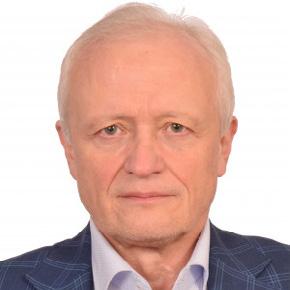
investment projects of Polish entrepreneurs to the European Commission, and in a short period of time nearly 50 developed projects went there from our chamber alone. The ability to invest in Ukraine will definitely be greater when the risk is taken by the state fund,” Jacek Piechota, former Minister of Economy in the leftist governments, and currently president of the Polish-Ukrainian Chamber of Commerce, told the Rzeczpospolita daily. The problem is that Italy, Belgium, Denmark, Germany or France have already decided to set aside money to support their companies, while Poland has not yet completed the formalities.
MP Paweł Kowal, chairman of the Council for Cooperation with Ukraine, stressed that the National Export Credit Corporation (KUKE) system already offers insurance, and now, in addition, companies will be able to use guarantees provided by the European Commission. The government also wants to allow local government entities to use them.
Experts agree that the main opportunities for Polish companies are related to energy, transportation infrastructure, urban reconstruction and municipal economy. There are already 3,600 Polish companies operating in Ukraine, and 300 companies with Polish capital were established during the war.

In the last 12 months, from August 2023 to July 2024, just over 259,000 children were born in Poland. This is the least since World War II.
23,500-that’s how many so-called live births were recorded in Poland in July, according to the latest data from the Central Statistical Office (GUS). This number alone is not bad compared to data from previous months - it’s the highest in six months. But a month earlier, in June, only 19,000 babies were born in Poland, the fewest in the history of the data.
The rate of decline in the number of births in Poland is high. As recently as 2023, some 272,000 children were born, 305,000 the year before, and 375,000 in 2019.
The continued decline in the number of births with a relatively constant number of deaths over the past year exacerbates Poland’s negative birth rate. In the
12-month period, the difference between deaths and births was about 148,000, higher only during the COVID-19 pandemic.
The decline in the number of births in Poland is a logical consequence of the decreasing number of women of reproductive age (15-49). There are now about 8.6 million of them, nearly a million fewer than as recently as 2010 and a million and a half fewer than at the beginning of the 21st century.
In addition, the fertility rate, the rate that tells how many children on average a woman will give birth to in her lifetime (assuming constant fertility statistics), has been declining
strongly in recent years. In 2023, it fell below 1.16 and was the lowest on record. It may turn out to be even weaker in 2024. In the 21st century, it used to fluctuate around 1.2-1.45, and even then demographers pointed out that this was below the low fertility limit.
Poland’s population at the end of July is estimated by the Central Statistical Office at 37.55 million people. Its 2023 demographic forecast assumes that in the medium scenario, Poland’s population will fall below 35 million people in 2042, and below 31 million in 2060.
Smooth state aid proceedings are a prerequisite for meeting the timetable for the Pomeranian nuclear power plant. And the balance of power in the European Commission has tilted in favor of the atom’s opponents.
The Polish representation in Brussels handed over to the EC a proposal notifying the planned state aid for the first nuclear power plant. As long as the required approval is not in place, the project will not be allowed to move forward.
The Office of Competition and Consumer Protection (UOKiK), formally the lead authority in the proceeding on the Polish side, says from an analysis of the EC’ s established decision-making practice that the socalled formal investigation procedure, conducted “when a complex substantive assessment is required,” is expected to be initiated. “The formal investigation procedure is carried out until all doubts are removed, and is concluded by a final EC decision (which may be a positive, conditional or negative decision). The Commission is obliged to endeavor to issue a final decision within 18 months from the initiation of the procedure (this deadline may be extended by agreement between the EC and Poland),” it wrote.
The government hopes to receive a decision sooner. Maciej Bando, the government’s plenipotentiary for strategic energy infrastructure, expects the Commission’ s proceedings to conclude no later than Q2 2025. This would be the most smoothly conducted EU proceedings on the government’s nuclear subsidies in recent years. More than two years passed between the submission of the notifi-
cation application for Czech nuclear investments and the EC’s approval. It was not much shorter for the Commission to consider Hungary’s application to build the Paks II plant.
A contract to build the plant with a consortium of US companies Westinghouse and Bechtel is scheduled to be signed in the second half of 2025. Without the EC’s approval, officials signal, it will be impossible to provide the investor, Polish Nuclear Power Plants (PEJ), with the funds necessary to move to the next phase of the project. Without that money, the contract will not be signed.
The support mechanisms proposed by Poland take into account the EC’s approach and the case law of the EU Court of Justice, and work on the proposal was finalized in intensive dialogue with Brussels. There are also arguments about the simpler construction of the Polish project than in the Czech case. The contractor for the power plant is a 100% state-owned company, with no other assets in the energy market. Its support - this is what the government is counting onwill therefore not require a meticulous examination by the EC regarding the impact on other players in the sector.
However, the political balance of power within the Commission, which has tilted sharply to the side of nuclear opponents, may play to Warsaw’s disadvantage.
The Office of the Plenipotentiary for Strategic Energy Infrastructure puts these concerns to rest, stressing that Poland has received assurances from the EC that the process of selecting and approving the composition of

the new European Commission will not affect the timing and workflow of the proposal.
The state aid requested by Poland, the legitimacy of which is now to be examined by Brussels, consists of three elements. The first is a PLN 60 billion recapitalization of the company by the Treasury. This is about 30% of the value of the entire investment. The second is guarantees to facilitate raising the rest of the financing. The third element is the so-called contract for difference. This is a mechanism that provides the generator with a surcharge when it sells energy below a set reference rate, while forcing it to return the surplus when it is the market quotation that is higher. The guarantee of stable revenues during the operation stage of the power plant is supposed to secure a fair return on investment.

The best quality of life among large cities is offered by Poznań, and among smaller cities by Sopot. This is according to the Healthy Cities Index compiled on the basis of statistical data.
Among cities with more than 300,000 residents, Poznań was rated best. It overtook Warsaw (the capital has had the most points in the ranking the last two years) and Gdańsk. Among smaller cities, Sopot received the most points, followed by Gdynia and Rzeszów. A high score (an index value above 60 points) was also recorded in Białystok.
The report was prepared for the third time by researchers from the Warsaw School of Economics (SGH), the Cracow University of Economics and the Lux
Med Group. Based on official statistics, including the GUS’s Local Data Bank, ProfiBase, the Agency for Health Technology Assessment and Tarification and the Central Examination Commission), the conditions for healthy living of some 12.4 million urban residents were studied. Dozens of factors were considered in eight areas of life: health, population, municipal and social services, education, housing, environment, infrastructure and space. The maximum number of points is 100, in which case the city would be an ideal place. Poznań scored 74.9, and Sopot scored 67.6.
Among the nine cities with more than 300,000 residents, Łódź, Szczecin and Bydgoszcz collected the least
points. The least points were calculated for Jaworzno, Mysłowice and Dąbrowa Górnicza among smaller cities.
The report shows that out of 66 cities, the number of residents increased in 38 over the year. In 2023, the oldest residents were in Sopot, while the youngest were in Rzeszów. Chorzów has the largest area of green space (more than 20% of the city’s area, the average of the surveyed cities is less than 8%). Katowice spends the most money on housing - 22% of the city’s current expenses (the average is just 5%). Zielona Góra, for the second time, achieved the highest spending on greenery maintenance - PLN 357,000/ha, which is significantly higher than the average of the surveyed cities - PLN 57,000/ha.
The authors of the report believe that the quality of public services provided by cities is improving. Examples include drinking water, the quality of which has improved significantly in recent years, or the level of public safety, which is high compared to other European countries in Polish cities and remains fairly stable.
Among the challenges of Poland’s largest cities are such elements as support for the area of psychiatry, a need that is evident through the still high rate of suicides resulting in death per 100,000 residents (22.3 people in 2023) and the growing number of economic crimes per 1,000 residents (from 7.43 to 9.55 in 2023).
Poland has been ranked among the most attractive markets for semiconductor manufacturing in Europe. Kearney analysts found that only four Asian countries fare better in the world for such investments. In terms of semiconductor manufacturing locations, only Taiwan, Malaysia, India and China were better ranked.
Poland’s position was not even harmed by the failed investment of the financially troubled Intel, which halted construction of its factory in Lower Silesia. Analysts point out that thanks to the cooperation of the Polish government with companies in the industry, including Intel, it was possible to develop a system of incentives adapted to such complex investments (the value of the planned state aid spread over 2024-2026 was to exceed PLN 7.4 billion). As a result, this part of the continent has already gained
attractiveness in the eyes of semiconductor manufacturers. However, it should be stipulated that in this case it is not about socalled front-end plants, designing and creating chips, but about back-end projects, which - in our case - would be a kind of backend and support of factories.
In a recent study, “Front-End Semiconductor Manufacturing Attractionness Index,” Kearney experts analyzed 21 countries and regions, ranking them based on their potential to attract semiconductor investment. At the time, front-end investments were studied. In formulating the index, the researchers took into account the incentive plans and other attributes of each country, including the business environment, access to talent, but also to the rare minerals needed to produce advanced integrated cir-
cuits. As a result, a severely limited number of countries qualified for the report.
Kearney expanded the “attractiveness index” to include backend potential. Such production includes, among other things, testing and packaging of individual dies. Experts point out that this is a less capital-intensive stage compared to the front-end, where more emphasis is placed on operating costs. This is where Poland has shown its strengths. The report looked at 30 countries and evaluated them in terms of their suitability to support semiconductor manufacturing. Such parameters as the regulatory environment, level of bureaucracy, quality of infrastructure and logistics, energy production capabilities, labor costs or tax issues, among others, were put under the magnifying glass.
Experts particularly appreciated in Poland such criteria as the amount of operating costs (including the prices of the necessary for production: water and energy, as well as labor costs or the amount of taxes) and incentives for investors. “Poland is a leader among EU countries, and the Polish government is working closely with companies (like Intel) to provide tailored incentives. The country is strategically well positioned because the EU offers a relatively lower operating cost option to support its front-end plants in Germany, Ireland and France,” the Kearney report reads.
Analysts note that demand issues aside, companies in the industry are facing increased geopolitical risk. “This is forcing them to look for alternative locations for their production network,” they wrote.
The result of looking for these alternatives was supposed to be an investment by Intel. Ultimately, it won’t happen (officially, plans have been suspended for two years), but even if Intel’s project doesn’t go forward, other partners may emerge. Among others, there is speculation about Taiwan’s TSMC (Taiwan produces about 90% of the most advanced processors). The corporation is building its factory in Dresden, so a back-end in Poland seems a viable option. James C.F. Huang, head of the Taiwan Trade Development Council, suggested in an interview with Rzeczpospolita daily that Taiwanese companies in Poland could invest in chip design and integration. “Your strategic position in the region makes Poland a good direction for our companies,” he explained.

Auchan and Intermarche are tightening their cooperation in Poland. The Office of Competition and Consumer Protection (UOKiK) has given its approval for the concentration and long-term shopping alliance of the French giants.
As a result of the decision, the French companies will establish a new legal entity in Poland, which, as a central purchasing entity, will represent both chains in discussions with contractors from the date of registration. Intermarche and Auchan Polska are to be equal owners of the company, whose headquarters will be located in Warsaw. Its structure will include representatives of both chains.
Both chains expect that their cooperation will translate into strengthening relationships with suppliers by broadening their business prospects, as well as increasing the attractiveness of the prices of the
products offered as a result of combining the purchasing power of the two brands.
“The ultimate beneficiaries of the alliance will be Polish consumers, who will gain access to a wide assortment of products at prices allowing them to manage their household budgets more economically,” the chains argue in a press release issued by Auchan Poland.
The scope of cooperation entails joint negotiations of terms and conditions for the purchase of private label, domestic and international food and non-food products with selected suppliers supplying these items directly to each chain.
Auchan Polska and Intermarche will also jointly purchase goods and services for their own operations.
“We welcome the decision of the president of the UOKiK very much. We are convinced that the partnership
cooperation will positively affect the development of the market, will bring benefits to all parties, and above all to Polish consumers, who will gain access to a wide range of products at even more favorable prices allowing them to manage their household budgets more economically,” stressed Alexandre Saussard, CEO of Auchan Polska.
“We are embarking on the next stage of our joint project, which will be reflected in the establishment of a new entity on the Polish market. We believe in the potential of our brands, which have a common vision of conducting cooperation with suppliers and manufacturers, for the benefit of consumers. We have matched the right resources to be able to effectively implement our assumptions counting on fruitful cooperation and results,” added Maciej Cwiklinski, head of Intermarche in Poland.
The Polish manufacturer is preparing to compete not only for the Polish high-speed train market, but also the Three Seas Initiative countries.
Pesa and Spanish rolling stock manufacturer Talgo concluded a preliminary agreement at the Innotrans trade fair in Berlin to cooperate in the development of a new high- and ultra-high-speed rail network in Poland. Signed by Talgo CEO Carlos Palacio y Oriol and Pesa CEO Krzysztof Zdziarski, the agreement covers work preparing the assumptions for cooperation in three main business areas: preparing a bid for the announced procurement process for high-speed rolling stock to be announced in Poland in 2025, other future high-speed projects in neighboring markets, and identifying opportunities for cooperation on other rail projects.
In Poland, a high-speed rail line connecting major cities, including Warsaw, Łódź and Wrocław, will be launched. This is the first of some 2,000 kilometers of new routes for passenger transport to be built in the next few
years as part of the Central Transportation Port (CPK) project.
Pesa wants to have a stake in these projects, hence it has reached out to Talgo’s expertise and experience. This Spanish manufacturer offers trains that accelerate to more than 300 km/h. Talks on cooperation have been going on for more than two years, and not only the terms of the agreement and the terms of the contract were negotiated, but above all technical teams worked to prepare the assumptions of the concept of a joint vehicle and the division of tasks in future projects.
“Pesa has been working on the development of the high-speed project for several years. From the beginning, we assumed that we would implement this project with a technological partner. Talgo’s and Pesa’s potentials complement each other, and I am convinced that together we will offer a vehicle that will perfectly fit the needs of carriers in the Polish market and the entire Three Seas Initiative region,” Zdziarski said.
Talgo specializes in the design, manufacture and maintenance of high-speed
and intercity trains, which are in operation in Spain, Germany, Denmark, Saudi Arabia, Egypt, Kazakhstan, Uzbekistan and the United States. It is a major supplier of high-speed and ultra-highspeed trains for Renfe and a train supplier for the “Haramain” project, the line between Mecca and Medina in Saudi Arabia. Talgo is also the manufacturer selected by Deutsche Bahn in Germany and DSB in Denmark to decarbonize passenger transportation with Talgo 230 Intercity trains. The company employs a team of more than 3,300 people of about 50 nationalities.
PESA trains and streetcars run in all regions of Poland and most major cities, as well as in more than a dozen European countries. Pesa streetcars are used by residents of Warsaw, Kyiv and Sofia, among others. Its vehicles carry passengers of Germany’s DB Railways, Italy’s Trenitalia, Czech Drahy and PKP Intercity, among others. The company is working on electric multiple unit for Romanian Railways and a new generation of vehicles for RegioJet, which will reach speeds of up to 200 km/h.
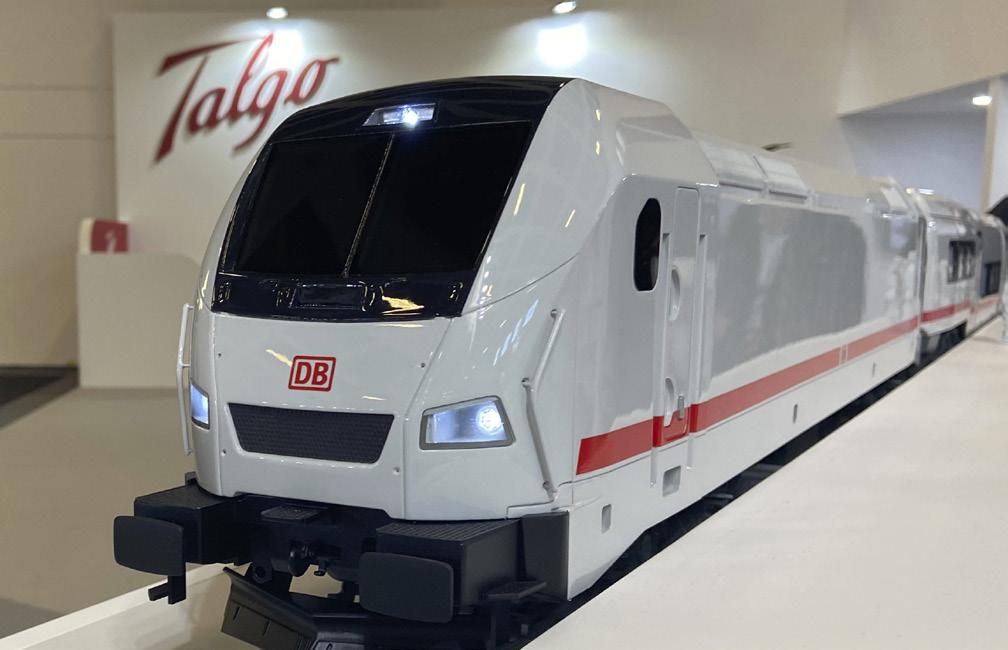

Authorized dealerships of the Mercedes-Benz Poland network took first place for the third consecutive year in the “Auto Świat” magazine’s Great Dealership Test. The magazine’s auditors comprehensively checked the quality of service at Polish new car dealerships, visiting 321 establishments. For each salon, dozens of parameters were evaluated, which make up three categories: salon organization, customer service, test driving.
The Mercedes-Benz brand ranked first among the 24 brands surveyed, including 8 premium brands, with an overall score of 94.3%; showroom organization was rated at an average of more than 99%, customer service at 92.6% (the highest rating in the survey), and test driving at more than 98%
“I am very pleased that Mercedes-Benz Poland has once again triumphed in the Auto World magazine’s Great Test of Salons. This is an emphatic confirmation that our success-
es of a year and two years ago were not an incident, as well as a reward for our hard work in maintaining the highest standards of service and updating the infrastructure of our network. Above all, however, winning the Grand Salon Test is a guarantee for customers - that when they buy a Mercedes, they can count on special treatment and a setting worthy of the oldest luxury car manufacturer in the world. I would like to thank all the employees of our network for their daily, diligent work. We rely on passionate people who are able to convey enthusiasm for the Mercedes-Benz brand and provide their customers with personalized care that often pays off with years of loyalty. And we don’t intend to rest on our laurels,” said Marcin Kwoka, Head of Market Operations Mercedes-Benz Poland.
One of the dealerships - Mercedes-Benz Auto-Studio in Łódź - was awarded the prestigious title of No.1
dealership in Poland, achieving scores of 100% in each of the three main categories. Most of the Mercedes-Benz dealerships surveyed earned an overall score of more than 90% and the title of model dealership. None of the Mercedes dealerships surveyed was rated lower than 85%.
The Great Salon Test has been carried out in Poland regularly for more than 20 years. This is the largest survey of its kind in Poland - every year it checks 30% of randomly selected domestic new car dealerships of a given brand, but no fewer than 10. The magazine’s envoys as customers visit the establishments and evaluate, among other things, the infrastructure of the facility, the reception at the dealership, the conversation with the advisor, the presentation of the car, the preparation of a comprehensive offer and the determination of the next steps towards the purchase of a car.